#stoned manga reviews
Explore tagged Tumblr posts
Text
TV SHOW REVIEW: NANA
★★★★★ - 5 stars
"Love, it's a story between two human beings so if you can't think of the other, it's possible it won't work."

NANA: two girls with the same name, on the same train, meet and fall into each other's lives. The drama, love and pain that blossom from their meeting ensues in a timely manner, unfolding in bouts of emotion before the viewer's very eyes. The beauty of the anime starts with it's characters who are woven so intricately - each of them individuals with intriguing backstories, trauma and completely different lives. Alongside the beautifully created characters, throughout the anime there are many references to Vivienne Westwood fashion, which makes NANA stand out as a punk love story for the ages. That's what NANA is about, whether you interpret the love between Nana Osaki and Nana Komatsu as romantic or platonic, the anime discusses the importance of love and friendship within our lives. The true matter that intertwines these characters however isn't fashion or love, it isn't even friendship - it's music. The husky, unique vocals of Anna Tsuchiya as Nana Osaki create a wonderful listening experience, and the songs 'rose' and 'zero' are undoubtedly the stand out tracks of the anime. The story that unfolds between two battling bands shows the complexity of relationships, as complications and heartbreak unfold between our very eyes, between performances and recordings. Full of funny moments and dramatic plotlines, a tale of music, found family and a masterclass in character creation, NANA is truly one of the greatest animes to ever bless the screen.
#film and tv#anime#nana anime#japanese anime#nana x nana#nana osaki#nana komatsu#nana#vivienne westwood#punk#punk anime#ai yazawa#nana manga#manga#anime and manga#anime review#tv show review#entertainment journalist#nana x hachi#nana x ren#hachi x nobuo#nana x nobuo#nobuo terashima#ren honjo#shinichi okazaki#takumi ichinose#yasushi takagi#the black stones#trapnest#ai yazawa manga
102 notes
·
View notes
Text
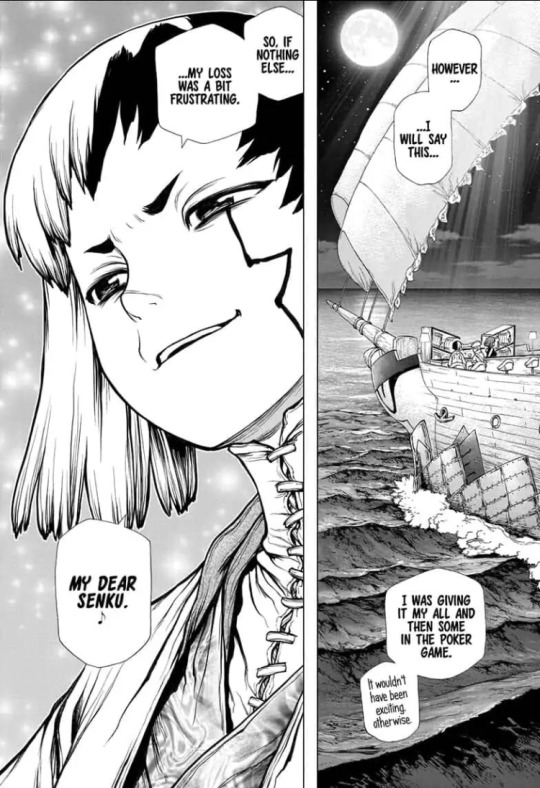
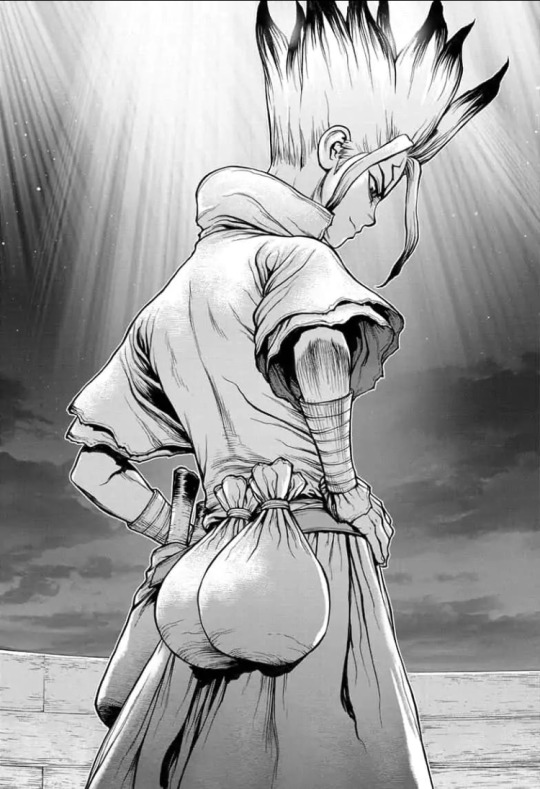
Once again going through my Sengen bs
#I want someone to gaze at me in the distance like that damn#I miss them revisiting my screenshots and I miss them so much#I have to review these ss at least like 2 times a month to remember soulmates#sengen is so real you guys the most canon ever#sengen#manga#dr stone#senku#gen
102 notes
·
View notes
Text
youtube
On the Hotline?! Dr Stone Season 4 Episode 5 Review
4 notes
·
View notes
Text
Fairy Tail 100 Years Quest Chapter 168 Livestream Discussion/Review: Great Power Pierces Stone!
Lucy has teamed up with Brandish in order to bring down Mercphobia once again all the while being able to get her hands on Aquarius's gate kay that is trapped within the Lacrima that was used to dragonified the citizens of Ermina into Dragons. In midst of the entire battle, The Water Dragon God devoured Lucy seemingly ending her life in the process. Or was this all apart of the strategy that Lucy and Brandish came up with to defeat him?
#Fairy Tail 100 Years Quest Chapter 168#Natsu Dragneel#Lucy Heartfilia#Happy#Gray Fullbuster#Erza Scarlet#Wendy Marvel#Carla#Ignia#Faris#Igneel#Acnologia#Dragon King Festival Fairy Tail 100 Years Quest Chapter 168 Review#Fairy Tail 100 Years Quest Chapter 168 Livestream Discussion/Review: Great Power Pierces Stone#Hiro Mashima#Rave Master#Fairy Tail#Edens Zero#Dead Rock#Fairy Tail 100 Years Quest#Anime#Manga#Anime/Manga
3 notes
·
View notes
Text
MHA 398
All Might is not right in the head. And I'm afraid Sir Nighteye's prediction is about to come true. He's truly doing everything for Deku and society. I'm worried. Live you old man!
Also love the flashback of Nana Shimura and All Might's first meeting. Also getting a glimpse of a truly devastated and cruel world before AllMight rose as the Symbol of Peace. I'm re-watching MHA right now. and on season 3. The climax of All Might vs All For One and just seeing how epic thi fight is becoming, I'm looking forward to it being animated.
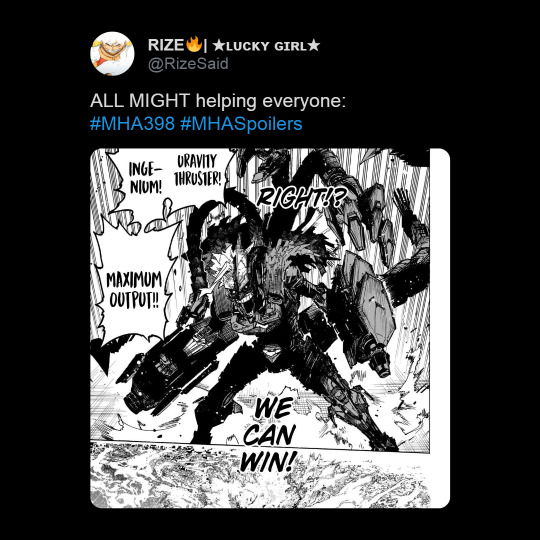
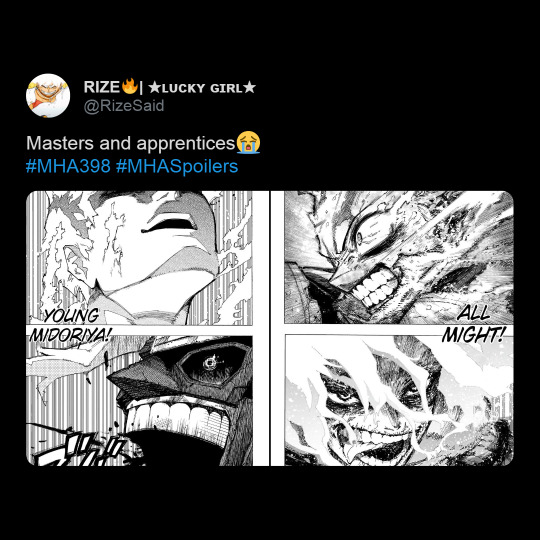
Got tears in my eyes when the vestige of All Might in OFA told Deku about All Might's fight. I don't want Deku to find out about All Might gravely injured or something worse like this.
#anime#anime and manga#anime recommendation#anime review#anime reaction#what i'm watching#One Piece#My Hero Academia#MHA#BNHA#Boku no Hero Academia#Jujutsu Kaisen#JJK#Attack on Titan#Shingeki no Kyojin#Bungo Stray Dogs#BSD#Fairy Tail#Dr Stone#Spy x Family#Hell's Paradise#jigokuraku#Chainsaw Man#Jibaku Shounen Hanako-kun#Oshi no Ko#Mashle#Kimetsu no Yaiba#Demon Slayer#All Might#Deku
12 notes
·
View notes
Text
Dr. Stone S3 Episode 1: New World Map
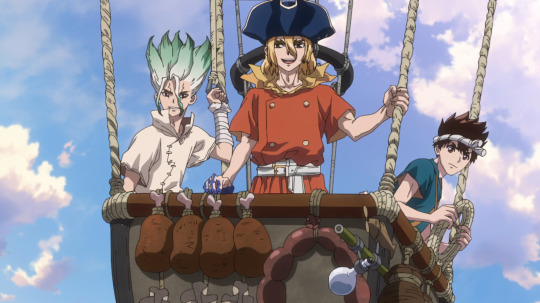
Looks like science is back on the menu boys! Dr. Stone returns with its third season (which is 2 cours once more!), with the goal of creating a ship to cross the ocean. An ambitious goal considering the technology of their time, but one that come Heaven or Hell Senku will complete. Though every dream that aims for the stars starts with a humble beginning, this one starting with a search for oil and the beginnings of agriculture.
It's been a while since I've really watched or paid attention to Dr. Stone stuff, so I've been reminded of how enjoyable the art and designs are for this series. They're incredibly tight and creative, and plenty vibrant without being overly contrasty or excessive in terms of color design. It's a really great balance that puts the focus on stranding out, and being strong.
And one last thing before I get into it, the direction for Dr. Stone has never really stood out to me. It's one of those things that just focuses on not getting in the way of the story and its characters. It leans perfectly into the comedy and excessive nature, but doesn't attempt to try and put a spin on things or really do anything crazy with it. Not exactly bog standard, but not something that you point out and talk about.
So with that in mind, I'm jumping right into science!
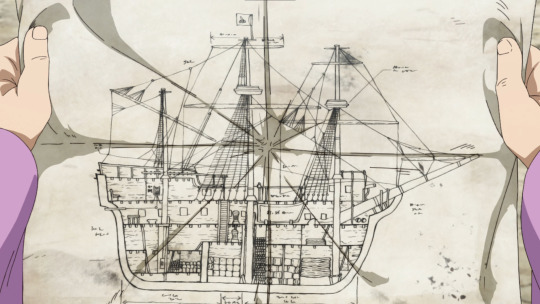
I thought this blueprint was rather fun, not really accurate in any way, but something and interesting to younger audiences for sure. The cross section is a solid idea for showing how it's supposed to look, and there's even measurements just poking their head out from the bottom of the image. But ultimately, it's slightly more than a glorified drawing of a cross section of a ship.
Now, two little tidbits here, not really important but just stuff I found fun. The first is Yuzuriha being put to work, considering her sewing skill it makes sense, but if it weren't clear to others she's the one that's putting together the sails for the ship which was a fun little background detail to add. Similarly, Kinro and Ginro are working together to plane the various logs into workable lumber. They weren't using it, but was fun to see them show off a planer (and helps remind you of the level of technology available to Team Science).
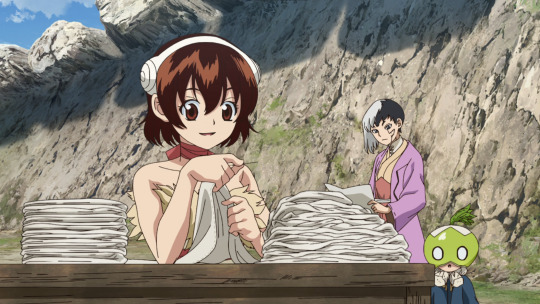
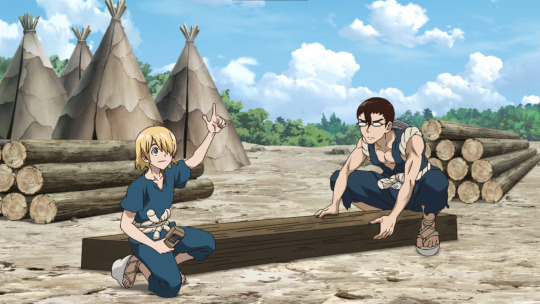
Now, I'm not 100% certain on what sort of tool Ukyou is using here. My immediate thought was a sextant, but that's used for celestial navigation and they're in the daytime and are surveying land. So, due to lack of knowledge I'm chalking it up to "funky telescope for charting topography".
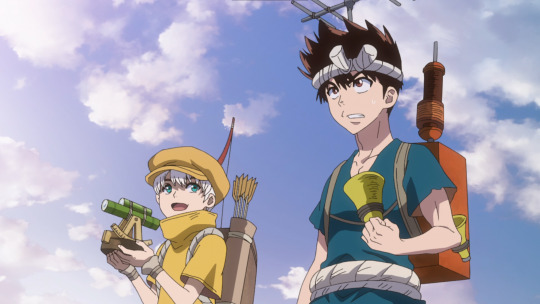
So, maybe not science, but I really enjoyed this piece as a bit of logic behind the crew's search in the skies. Rysui points out the existence of a herd of wild animals. Now, for a herd to support itself, there must be sufficient food in the area, which Team Science also happens to be after. Sort of a two birds with one stone moment that works out quite well for them as they stumble upon wheat, of all things.

So, on the topic of wheat, I was kind of sad that they didn't explain this little piece here. It's a fun and interesting little thing that helps with an overall mundane task. Threshing is the stage where you separate the stalk/straw that holds all the wheat together, and the more traditional way to separate the two is, essentially, to smack it against something. Because of that, seeing it done in a much more refined and controlled manner was interesting, so I was kind of disappointed they didn't add any dialogue to the scene.
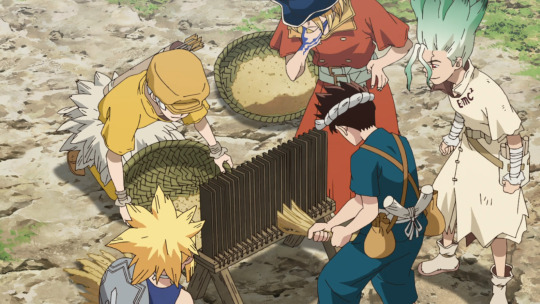
And the last real science-y thing of the episode was a litmus test. A really fun and simple example of the importance of stuff that you might have thought random when in high school. Litmus paper (and acid-base testing in general), is applied in all manner of facets of modern human life. Seeing it as such a simple yet important example was really fun and inspiring, and a cool way to casually teach people about the challenges of agriculture.
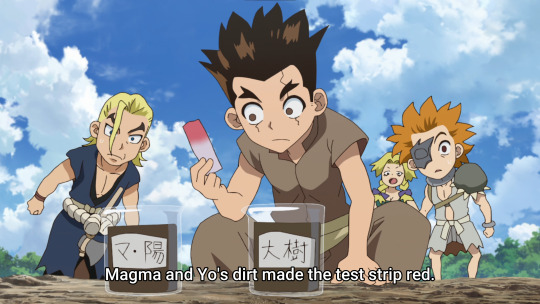
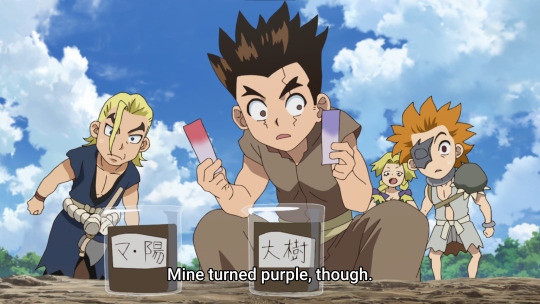
Of course, Dr. Stone isn't purely about scientific advancement, so they throw in some sentimental moments as well. In the smaller dosages that we see them in, they serve the story perfectly to allow for the characters to develop, and to help frame the importance and magnitude of the advancements that color human history.
Though you'd be kidding yourself if comedy didn't reign supreme after science. The sort of chibi style that appears just helps accentuate the ridiculous nature of the comedy, while separating it comfortably from the more scientific or sincere sides. It's basically a textbook approach that's executed incredibly well.

And lastly, Minecraft is in an anime. Yeah. Weird, yet awesome decision to have some of the exposition scenes appear as something styled after Minecraft, given the similarities. Great fun, and a cheap and easy solution to those moments, which can allow them to put more focus elsewhere.

#dr. stone#gen asagiri#senku ishigami#yuzuriha ogawa#dr stone ryusui#ryusui nanami#dr stone#dr. stone new world#dr stone new world#anime recommendation#anime review#anime and manga#anime
9 notes
·
View notes
Text
REVIEW | "Dr. STONE" - Vol. 26 [FINALE]
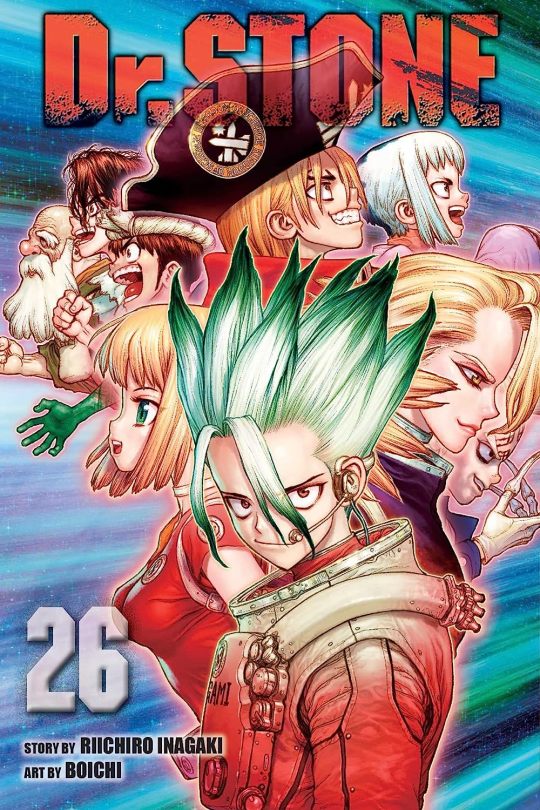
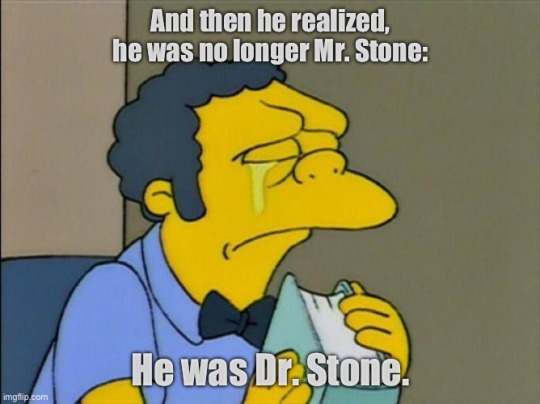
Click here to read the review!
#king baby duck#boston bastard brigade#reviews#manga#comics#comic books#review#viz media#shonen jump#dr. stone#riichiro inagaki#boichi#black compat#the simpsons#simpsons meme
3 notes
·
View notes
Text
The new trailer for Witch Hat just revealed the glyph for the most important spell in the entire manga; the petrification spell.

These past few days, I’ve worked tirelessly to decipher this spell. While many questions still remain, I’ve made a crucial discovery; petrification contains a time stop spell.
If my theory is correct, this means that just before Coco’s mother was petrified, her time was stopped. This would have prevented her death, and placing her in stasis within the stone. This would mean that she can be saved.
For an in depth look at my research on this spell and the discoveries I’ve made, please read the google doc below. I think you’ll find it interesting.
#tongari boushi no atelier#witch hat atelier#atelier of witch hat#tongari booshi no atorie#wha#wha spells#tbna#δ帽子#magic analysis
1K notes
·
View notes
Text
Sukuna’s Loneliness Part 5 (Sukuna Did Nothing Wrong in the Heian Era, Probably)
Part 1 Part 2 Part 3 Part 4
Some notes before we start.
1) Big content warning for in depth discussion of historical slavery and the exploitation of minority groups.
2) I will be mainly using the TCB scans for the manga because of their accessibility.
3) Raws are from Mangareader(.)to.
(Click images for captions/citations.)
Preface
This is another case of me making everyone suffer the consequences of my fic research. I finally got my hands on 100+ page THESIS on the lives of the lower class in ancient Japan that references multiple peer-reviewed sources. This is my holy grail. Please read all of it. (Thank you Mr. Breann M Goosmann!) Whenever I quote something, I am quoting this source. Most of what I'm summarizing is directly from this source.
Gege may have failed to write a proper backstory for Sukuna, but one was clearly set up using the actual history of that time. So I'm here to infer what's in those gaps using this document.
The Class System in Ancient Japan
During the Heian Era (794–1185) a social caste system called Ritsuryō (you can read more about its application here). The upper class was called 良民 or Ryōmin (good people) and the lower class was called 賤民 Senmin (low people).
The kanji 民 (Min) used for both of these classes can be translated as citizen instead of person. The Wiki page I linked uses the citizen translation. I have decided to change that to people because of 3rd group of people excluded from this system: The 非人 or Hinin (non-people).
Ryōmin included court nobility, citizens, professions that served the court, and tradesmen.
Senmin included servants and slaves.
Hinin included criminals, the deformed/disabled, and those working professions considered "unclean."
The most notable thing about this class system is the mobility between Ryōmin and Senmin. Committing crimes, selling oneself into slavery, aging, paying off debts, and doing good work allowed people to rise or fall from the ranks accordingly. Hinin, however, were confined to their class for the most part because many were viewed as innately "unclean".
Ironically, the best way to understand how this class system functioned is to understand what being "unclean" meant to it.
Uncleanliness (Kegare)
穢れ (Kegare) is a term that can be translated as the following: uncleanliness, defilement, pollution, impure.
晴れ (Hare) is a term considered the opposite for Kegare and can be translated as the following: to clear up, clear skies/sunny, renew, dispel, sacred, pure.
Both of these terms largely inform of how ancient Japan functioned and evolved over time. And though not a black and white dichotomy, it can be generally understood that society was organized in a way to minimize Kegare.
What's interesting about Kegare specifically is its complexity and its impermanence. Rather than being something only bad people have, anyone could acquire and dispel it through the proper rituals.
From the Kojiki, a Shinto document compiled before the introduction of Buddhism, and therefore before the Heian, separates Kegare into 2 categories:
1) Touch Kegare: Defilement through the physical contact with something unclean such as bodily fluids and the dead.
2) Transgression Kegare: Defilement through sinful actions.
"These versions of pollution appear as transient, exorcised relatively simply through misogi (cleansing ritual), seclusion from society, or expulsion of disorder causing elements."
This understanding of Kegare then evolved with the introduction of Buddhism to Japan. (This began in the Nara Era and extended well into the Heian.)
"As Jacqueline Stone explains in her study of deathbed rites and rituals, someone who had become enlightened was considered to have a “pure” mind, while those with a deluded mind were said to have a “defiled” mind. Monastic Buddhists also followed their own codes of “pure” conduct such as refraining from the eating of meat and killing of animals."
The old Shinto understandings of Kegare still carried over with the physical avoidment of unclean things such as dead bodies and blood. However, Buddhism introduced the idea that certain groups of people were innately impure. This includes the Hinin who were uniquely ostracized by this system.
"Hinin, like all outcast groups were bound to their “defiled” status. However, unlike other outcasts, they were also cast as blasphemers of Buddhist doctrine afflicted with karmic illness."
But despite being seen as this innately impure, the religious institutions were closest to them. Of the few places in society willing to tolerate and deal with Kegare, they offered outcasts "positions" where they could beg, display themselves as what happens to people who don't follow religious doctrine, and help with jobs considered "unclean". Since outcasts were considered permanently defiled for the duration of that life, they could touch impure things such as the dead, the sick, and blood on behalf of those avoiding temporary Kegare.
This is exploitation point blank. And though this suggests outcasts had some agency when it came to their survival, it doesn't remove the systemic coercion driving their situation.
Please keep this in mind as I explain why Sukuna did nothing wrong.
Sukuna is Hinin
Though there is plenty of debate on what makes someone Hinin, the general consensus is the following:
"All agree that hinin were considered defiled by others in society and looked at with some contempt. One medieval reference book called the Chiribukuro explains that hinin and other outcast groups “are alike in that they are shunned by human society.”"
But when trying to define Hinin more narrowly, this is the result:
"the term hinin indicated a very specific group of social outcasts isolated from the community and cast aside due to disease or deformation. In his description of hinin, Nagahara explains that those referred to as “kojiki-hinin” were of the lowest social class, physically isolated from their families and communities and therefore excluded from society and economic activities in the medieval period."
Sounds like Sukuna, right?
Sukuna does not refer to himself as Hinin of course, but he does call himself 忌み子 (Imigo).

To quote myself from Part 1, Imigo can be translated as "Abominable Child", "Unwanted Child", or "Shunned Child." None of these translations in my opinion get across how severe Imigo is. It's closer to meaning "child who should've never been born". Like the child's very existence is an affront to god. (If you play Elden Ring the Omen are called Imigo in Japanese for this reason.)
And since we know that Sukuna is canonically a conjoined twin, aka someone with a visible deformity, this all indicates he was considered afflicted with a "karmic illness" that would classify him as Hinin.
This means that from birth, Sukuna was designated as fundamentally unclean and non-human. Within that society, there was no route he could take to remove himself from this uncleanliness and be seen as human.
The following views of Hinin were considered controversial for their time (during the Kamakura Era aka right after the Heian):
"Although Nichiren believed in the karmic nature of certain diseases, he also understood that this kind of disease was not a hindrance to salvation."
"Undoubtedly, Eison envisioned hinin as the physical representation of the Bodhisattva Monju and advocated that compassion and charity were the appropriate response to karmic illness."
And since these controversial views of *checks notes* considering Hinin worthy of compassion and salvation were documented after the Heian, I don't think it's unreasonable to assume Hinin had less advocates during the Heian.
In other words, Sukuna could not exist within human society without being shunned or exploited. The manga itself suggests this has always been the case.

As you can see Sukuna is absolutely miserable performing a ritual someone of this lower class would be responsible for overseeing. All while the people he is helping regard him with disgust. (By the way there is a purification ritual in Nara called Yamayaki that involves burning an entire mountainside. Something Sukuna's flames would be very good at.)
This is also from the same chapter where he's assaulted by Yorozu who assumes he's lonely because he's strong. She's wrong about this. Just like Kashimo who assumes Sukuna cares little for love for the same reasons he does.

Love from one person is worthless when compared to the nonstop ostracization that comes from institutional discrimination. At most, love can offer relief from that pain. It does not eliminate it. I'm saying this as a minority myself. I love my friends dearly and they love me as well, but I still wake up and go about my day with the soul-crushing knowledge that most wish for me to not exist.
Sukuna is not lonely because he's not loved. Uraume clearly does. It's that for circumstances beyond his control, he has been excluded from human society and forced to constantly be around people who exploit him for the very traits they scorn.
Sukuna pretty much confirms this himself when he talks to Mahito.

And you know what? Sukuna deciding to kill all the people exploiting him is completely justified. (Imo, he can even kill the non-sorcerers that discriminate against him as a treat.)
The Cannibalism was Justified too, for the most part.
Another thing to note about Sukuna. He was born starving and he died starving.

Famines and natural disaster were frequent and extremely hard on the commoner population during the Heian. The fact Sukuna was born starving indicates he was of lower birth to begin with since nobility hoarded the resources to avoid starvation for themselves.
One way for commoners dealt with famine was via foraging. We actually see Sukuna doing that when he meets Uraume.

Now there are several very interesting things we learn from this.
1) Sukuna hunts and eats elk/deer. Something massively taboo for the time. Especially since deer were considered sacred animals back then and even to this day.
2) He appears to wander around and owns very little. This is further in line with him being Hinin per the following:
"Clearly, welcome could be revoked at any time, which meant that hinin had to be prepared to leave any location at any given moment. This mobile lifestyle also meant that hinin could only afford to carry essential daily items, such as cooking utensils and begging bowls. The image also reveals that the hinin were never officially invited to stay in that particular area. Instead, they sought out their own locations to set up communities."
3) Despite Uraume being alive and fresh human meat, Sukuna does not immediately see them as food. Nor does he attack them. This, combined with him not taking the dead villagers for eating and preparing deer/elk instead, suggests that cannibalism is not the default for him.
Back to famines, it's also not unheard of for people to resort to cannibalism during them. The logic is simple: An outcast with no support network eats humans to survive.
And given the frequency of death from natural disasters of this time, there’s a real chance he never had to hunt humans in the first place. As Hinin, handling the dead is one of the few jobs he’s allowed to do. So it’s possible the worst thing he did was desecrate corpses in the name of scavenging.
Furthermore, if Sukuna is considered a non-human, is it even cannibalism to begin with? Is a hungry animal evil for eating a human?
I may consider Sukuna human because I refuse to partake in his dehumanization, but it needs to be understood that in the context of the JJK's story, there is not a single character that refers to Sukuna as a human. He's not even referred to as a man. He's either a curse, a monster, or at the very end, a sorcerer. Sukuna has been so dehumanized by others that he himself identifies as a "curse". This is also separate from "cursed spirit", leaving him in his own unique category of non-human.

Sukuna may not see eating other people as acts of cannibalism. After all, they are the ones who decided he was non-human at birth. (And since he is taboo, eating the deer/elk can’t make him more taboo than he already is.)
The following is an excerpt discussing the dehumanization of the starving:
"This strange image is from the Scroll of Hungry Ghosts and the huge emaciated creature depicted is just one of many of the numerous depictions of hungry ghosts or gaki. Invisible to humans, the gaki depicted are the spirits of greedy or jealous individuals karmically punished for their covetous thoughts with perpetual hunger for bodily excretions such as urine or feces."
"The protrusions of the stomach, the red-tinted hair, as well as the greying of the skin, are all genuine symptoms of starvation. In this light, our image appears significantly different. Instead of an invisible monster attacking a man, we have a disfigured and suffering human reaching out for humanity."
The phenomenon of hair during red or blond from starvation is called Kwashiorkor. Gege may be color blind, but Sukuna being depicted with pink or blond hair appears to be deliberate and in line with Kwashiorkor.
Sukuna was probably framed.
The only crimes Sukuna is accused of by Jujutsu Society is murder and cannibalism. As demonstrated by the previous section, there could be a pretty good reason for the cannibalism. But what about the murder?
Another thing that should be noted about Sukuna is how his destruction is largely retaliatory in the modern era. Every kill or kill attempt is made as a response to a challenge that was directed at him first.
When Sukuna first incarnates, Megumi says this to him:

Yuji may be Megumi's target, but remember that Kegare spreads through touch. Sukuna coming into contact with Yuji has made them both unclean. In other words, Sukuna has been informed that in this life, 1,000 years later, where he has yet to do any harm (Those comments about the women, children, and massacre are still sus, but they could've been about the Merger.), he will be attacked by sorcerers no matter what. It's not unreasonable for him to then attack them on sight.
But even when he does that, most of them survive until Shinjuku. During the culling games, Sukuna kills only 2 sorcerers—Ryu and Yorozu. Ryu is given a chance to walk away, but he doesn't. Uro flees and is spared. Yorozu is the sole person Sukuna seeks out to kill and that’s just for his Gojo plans.
And in that month Sukuna has before the showdown with Gojo? Nothing happens. He kills no one and just lounges around. Eating his own corpse is the only cannibalism. He absolutely could have eaten Tsumiki’s body to further crush Megumi’s soul, but he doesn’t.
Then when it comes to the actual showdown, Sukuna kills 3 sorcerers total. It's also very telling that after Sukuna is dead...no one blames him for what happened. They blame Kenjaku, hell even Gojo, but Sukuna isn't mentioned once. Higuruma is convinced that Sukuna was playing around. Kusakabe agrees that Sukuna’s manner of play isn't what they’re super worried about, it's Kenjaku.

The worst thing Sukuna does is Shibuya and that too has nuance to it. The twins aren't killed for fun. Sukuna punishes them for making demands of him. The citizens of Shibuya? Collateral from dealing with Jogo and Mahoraga. (He only really kills Haruta for the sake of it. And let's be real, he deserved that.)
And though the Shibuya civilian deaths are an objectively bad thing Sukuna has done, the fact they are not intentional gives credence to the idea that Sukuna didn't really target them in the past either. This suggests that the "murders" Sukuna did in the Heian were likely retaliation against people challenging him or trying to subjugate him. In other words, self defense.
And if he did wipe out a village, it was probably collateral. But that's kind of the thing. Did Sukuna even kill innocents by accident? The only confirmed kills of the Heian are those of the Subjugation and Military Squads. You know, people who may have attacked him for simply being "unclean".
Who am I kidding he absolutely was attacked for being “unclean”. This is how Angel talks about Sukuna and the incarnated.

She doesn’t care about saving the lives of innocents, all that matters to her are things that she deems evil are purged. Sukuna to Angel is ontologically evil and doesn’t deserve to exist. She targets him more than other incarnated players while ignoring Kenjaku who is responsible for this mess in the first place. She also quite literally did something she deemed wrong and evil so she could follow him into the future and make sure he died. (Move over Gojo Satoru we've got a new minority hunter.)
But it’s not like her attitude is new. Jujutsu Society is notorious for trying to kill things they deem "bad" such as Yuji and Yuta. The striking thing about the wanted executions of these literal children is that the higher ups giving the command make other sorcerers do it for them. Going back to the ideas of Kegare—spilling blood and touching corpses makes one impure so the outcasts are to deal with it. This is the logic driving their decision to coerce Yuta into a binding vow to kill Yuji.

("No matter how many cursed spirits you kill, it's proof of nothing!" <Please take note of how Yuta's good deeds do nothing to earn the higher ups' favor because he's seen as inherently evil.)
Yuta is essentially scapegoated through this manipulation and Yuji initially treats him like an enemy. In the same way characters like Kusakabe blame Gojo for refusing to execute Yuji. Despite the higher ups being responsible for the system functioning this way, the people they’re manipulating bear the brunt of responsibility to other characters.
Who's to say Sukuna isn't also a victim of this scapegoating? His power is comparable to a natural disaster. It would be very easy to blame one on him. After all, the higher ups of the Heian, the Fujiwaras, did exactly that to Uro.

Uro’s situation is much worse than Yuta’s however. She is a military slave. This distinction of military slave is important because unlike domestic slaves, they were allowed to rise through the ranks and be given awards despite their status.
And since Uro is a Sukuna parallel, there is a pretty good chance he was a slave at some point during the Heian.
Slavery in the Heian
A little detail I left out when discussing famine in the Heian. The asymmetrical wealth distribution was so severe during this time that commoners would sell themselves into slavery in hopes of not starving to death.
An example from the Kamakura Era (after the Heian):
"As the article shows, during the three years of the Kangi famine (1229-1232) and several recovery years following, various common people sold themselves, their relatives, and their retainers into slavery in exchange for sustenance. Not only would an amount be given to the seller, but also presumably whoever now owned the sold individual would be responsible for feeding and providing shelter for that individual. In this way, the common populations of Japan created a strategy for survival. There was no certainty that a new owner would fulfill this obligation, but the promise of reprieve from daily struggles was impetus enough for the sale."
Another example from the same era:
"A didactic tale from 1283 tells the story of a small family consisting of a mother and son, who after experiencing severe famine, came to the realization they would soon starve to death. In the hope of saving his mother, the young boy offers to sell himself into bondage, and although the mother disagrees, he goes ahead with the plan."
Yes this is as bad as it sounds, but there is one thing I would like to get out of the way—this slave system did not function anything like the chattel slavery during colonialism. Strangely enough, these slaves had some rights they could fight their owners in court over. They could pay off debts and be set free. They were allowed to be married and have children with those outside of their class. They were not kept in cages or in chains like animals. (Silver linings! /s)
The term used for these slaves was 奴婢 (Nuhi) which roughly translates to “bonded person”. This is more in the contractual sense rather than the physical sense since most were slaves by contract or debt.
This kind of sounds like something binding vows could do, right? Well binding vows share no kanji with Nuhi using 縛り(Shibari) instead. However, Sukuna introduces the concept of binding vows with chains and a handshake.

Sukuna was also born unwanted to a starving mother during a time when starving people sold themselves or their relatives into slavery to survive. This can mean a lot of things for his upbringing and none of them are pleasant.
Here is a summary of what jobs Nuhi did:
"As stated previously, wealthy households frequently obtained slaves and assigned them to various domestic tasks. However, sources further illuminate trafficking of women into the sex trade of Kamakura Japan."
If you noticed, Sukuna's Cursed Technique is perfect for this. He can chop up veggies, butcher fish, till farmland, slash and burn farmland, light fires, and every other non-violent thing a knife and fire can be used for. If he wasn't exploited for exorcising curses, he absolutely would've been exploited for domestic tasks.
And to get to much more depressing line of work Sukuna could've been subjected to as a child, I'd like to discuss why someone as masculine as him would be associated with women's work in the first place.
The Treatment of Women in Ancient Japan
"In Japan prior to the Heian and Kamakura periods, women played prominent roles in religious activities as miko, which was akin to a female medium or female shaman...Since miko functioned as a sacred and integral part in religious communities, issues of impurity did not appear to be an issue. Instead, it was Buddhist ideas that linked the female form to impurity."
With the introduction of Buddhism, women began to be seen as innately impure due to the blood and fluids associated with childbirth and mensuration.
"In the Heian period, Buddhist temples such as such as Enryakuji and Tōdaiji, began barring women from entering the premises due to their defiled nature."
"prominent Buddhist discourse painted women as innately defiled and therefore unable to achieve enlightenment in their own female bodies."
"To be born as an innately defiled female was considered a karmic punishment for past actions."
Though not ostracized as much as outcasts, women were seen as innately unclean in a similar vein to Sukuna. Women were expelled from religious institutions but not the courts, while outcasts were tolerated by religious institutions and barred from the courts. (The courts and temples operated independently of each other, which is why it was possible for noble women to hold power despite being designated as unclean.)
A few months ago I made a joke about this panel:

"Sukuna’s two options were helping Uraume transition or becoming a girl himself."
This is still mostly a joke, but I do think Sukuna identifies more with women than with men. Not that Sukuna is a girl, but that he relates to them and their struggles better. (Keep in mind he does wear a women's yukata and a men's obi at the same time as Yujikuna.)
It's important to note is that this mystery woman here wears the clothes of a Miko or Shrine Maiden/Priestess—the main group of women that was displaced and persecuted because of the new religious doctrine. And like every other group without a proper social safety net, selling themselves into slavery became a survival strategy. They did have other options of course. In the case of Asobi, the Priestess that used to serve the courts, turned to entertainment and sex work after their exclusion.
"Either riding in boats or setting up shop on busy routes to the capital and religious sites, Goodwin argues that these performers were part of independent, possibly female-run organizations, which were not stigmatized until the later part of the Kamakura period. However, as Wakita Haruko has examined, at least some women involved in sexual entertainment were female indentured servants, serving as security on a loan issued by their parents."
In this way, the exact identity of the Miko in Sukuna's path may not matter. She might be a representation of those who accepted their exclusion and did their best to survive on society's terms. If the South choice is meant to represent returning to who Sukuna used to be, then it can also mean the types of struggles Mikos faced are his as well.
However, there was a temple that continued to accept women as followers—the Muroji Temple in Nara. Interestingly enough, this temple contains an inner sanctuary devoted to the founder of Shingon Buddhism, the type of Buddhism Tengen brought over. The mountain this temple is located on is also associated with a dragon spirit. Since there is historical precedent of at least one temple accepting a group of people seen as innately impure, a place like this may have also been a sanctuary for Sukuna.
With the information we have, it's not really possible to know exactly what awful thing happened to Sukuna. The most important takeaway from this is that the suffering he experienced was systemic. He didn't get unlucky with a few ignorant and bad people. This was the direct result of the Heian class system dehumanizing people. In other words, his choices were severely limited.
Sukuna's Other Choice
Going North with Uraume appears to be very similar what he did back in the Heian—taking in an abandoned child and looking after them. What makes this choice slightly different this time around is that the class system that oppressed him no longer exists in the modern era. Yes, he’ll absolutely face discrimination for being deformed, but the complete denial of his humanity at every turn for his appearance is gone. He won’t be treated as untouchable and inherently evil. Legally speaking, he has drastically more rights. Violence won’t be his only option moving up in the world.
I will always loathe that Sukuna had to die to obtain this. And that the “reformed” modern Jujutsu Society refuses to acknowledge the systemic failures of their institution. Kusakabe makes it very clear he still believes the immediate extermination of anything deemed “evil” is a valid way to go about things, even if it means the death of a child…as long as he doesn’t have to do it. (Hence him blaming Gojo for it, just like the higher ups.) After the fight, everyone passes blame around, absolves themselves of any wrongdoing, and decides no one is really at fault.
There were people at fault for this. There are institutions at fault for this. But their failure to confront those things directly is probably why Sukuna rejected Yuji’s offer so viciously. Instead of trying to understand Sukuna on his own terms, Yuji showed him the value of a simple life he was never allowed to have, then told him to die or go back into the cage.

Yuji offered Sukuna pity but no autonomy, which is exactly the way Hinin were treated by the religious institutions of old.
"However, Hosokawa argues that even in veneration of hinin as representations of Manjusri, Buddhist monks continue to discriminate against this outcast group and further perpetuate their low position in society. Hosokawa explains that although activity involved in charitable works towards hinin, Eison cared little about the salvation of hinin because he saw outcasts as divine only within the context of the ritual of assembly. Therefore, all charitable works directed at hinin were merely ceremonial. Hosokawa advocates the view that Eison believed hinin lacked ‘nature,’ meaning they were unable to study or practice Buddhism. Essentially, without nature, they had no ability to escape the cycle of re-birth through the study of Buddhism."
Sukuna even thinks of modern sorcerers like the ones of old. Why would he ever want to return to that?

His goals are simple; eat, play, and pass time until his dies. That’s not really evil now is it? But the people attacking him don’t know that. None of them ever stopped to asked because they assume him existing freely will bring evil.
But what does Sukuna do when he’s given a month-long truce a body he completely controls? He does what every minority group does when they are no longer being actively oppresed—he rests. He doesn’t go around killing or tormenting for fun. With his newfound freedom he secludes himself and lounges.
The fight in Shinjuku is essentially a group of well-meaning people from a corrupt institution beating an outcast that was ostracized by it into submission. Albeit for very good reasons.
Why did this fight change his mind?
If Sukuna is basically reliving past trauma via the Shinjuku fight, why did he decide this group of sorcerers was worth listening to? The simple answer of course is he lost to them. Sukuna believes the strong impose their will and the weak follow suit.

I don’t think that’s quite right. Sukuna used to be weak too. He was a child once. He used to controlled by others stronger than him. By his own logic he should’ve stayed like that, but he trained to get stronger and eventually rebelled.
Since Sukuna is a known liar and hides his feelings under several layers of repression, I’m inclined to believe this statement is also smokescreen. And after reading the Uraume Epilogue I am certain of this. But for now let’s revisit the Shinjuku fight, starting from the battle that made me realize Sukuna is indeed a pathetic sopping wet cat underneath it all—Sukuna vs Gojo.
Sukuna vs Gojo
Something fans picked up on during this fight was how Gojo dogwalked Sukuna when it came to Hand to Hand (H2H) combat. During their fight, Sukuna fails to land a single punch on Gojo’s face. It takes Yuta possessing Gojo’s body and fumbling around in it for Sukuna to finally punch that face. But it’s not just Gojo he sucks at with H2H combat. It’s everyone. Here is a compilation of Sukuna getting hit in the head or face.

This seems to conflict with Sukuna’s ability to learn anything visually. He sees someone do something and he can copy it immediately. This contradiction can be explained by him being Hinin.
Sukuna was considered an untouchable. Educated people were of a higher class and believed unclean things like him were to be avoided at all costs. This means that whatever education Sukuna obtained for himself was always at a distance. Aka watch and copy. And since H2H is mostly taught through body to body contact, Sukuna wasn’t allowed a proper sparing partner outside of the attempts to kill him.
In Part 2, I go over Sukuna’s fraud allegations for his copying of Gojo in particular. This is what lead me to realize that Sukuna spent 6 months plotting to kill a guy he met for 10 seconds. This insane level of pre-planning is also shaped by him being Hinin.
We know for a fact that Sukuna hunts deer/elk and that it’s safe to assume he driven to this because of his Hinin status. If you know anything about hunting, it’s that most of it is playing psychological mind games with creatures that are somehow complete geniuses despite having 2 brain cells. You don’t chase after a deer with a gun, you become obsessed with them. You study every little habit of theirs; when they hunger, what they eat, and where they defecate. Using this information, you set up the bait and wait in hiding for the perfect opportunity to kill them.
This is pretty much what Sukuna does to Gojo. He’s got a hunter’s obsession with him. In Part 4, I explain how this obsession might actually be unhinged courtship, but I don’t lay out why Gojo of all people seemingly means this much to Sukuna. This too can be explained by him being Hinin.
I’ve said it over and over, Gojo and Sukuna are twin flames. They are the strongest, isolated, dehumanized, exploited, self-taught, and really bad at showing affection. Part of this obsession is driven by Sukuna seeing himself in Gojo. He's being ordered around by others weaker than him in the same way Sukuna used to be.

But take note of this “I owe you a debt.” It’s easy to assume he means payback for punching him in the face. However…Gojo did actually do Sukuna a massive favor. He suspended his execution, even if it was primarily to save Yuji.
As I discussed before, Kegare was infectious. You touch something unclean and you become unclean yourself. By laws of Jujutsu Society and by social stigma around Kegare, Sukuna made Yuji equally as impure as himself. And Gojo went screw that, I’m going to look after you. He gave Yuji direct lessons, made sure all his basic needs were met, and treated him like a human. Behind everyone’s backs he hid the final finger, intending to let Yuji live for the duration of his natural life.

To Sukuna, Gojo is someone who would have taken him in and advocated for his humanity under different circumstances. Gojo is someone Sukuna would’ve loved to have as a teacher. And so he copies him. He learns and improves his own sorcery as if Gojo had intentionally taught him.
Through the Shinjuku fight, his experiences within Yuji, and Megumi’s memories, Sukuna gets a taste of what could’ve been. With Megumi in particular, he also gets to see what it’s like to be raised by someone who actually cares. Though not intentional, this is how Gojo teaches Sukuna love. This is why when Sukuna looks at Gojo, he thinks about love.

Sukuna choosing to go with Uraume is him copying Gojo one last time. After seeing that even if you’re isolated, exploited, and miserable, there’s still fulfillment in using your power to make sure someone else doesn’t go through what you did. It may not remove all that pain, but it makes it easier.
And bringing back Kegare’s opposite Hare (晴れ). The kanji used are in the Appare Da (天晴れだ) when Sukuna tells Gojo, “You cleared my skies.” (The Da at the end of this statement means it was pretty heartfelt too.) With this additional context, I think it can be taken to also mean that Gojo made Sukuna feel like he wasn’t impure.

Sukuna vs Yuji
Yuji and Megumi are the ones who ultimately make Sukuna realize that it's worth pursing guardianship regardless of marital status or blood relation. They are the two of Gojo’s students/children that are directly compared to Uraume.

Yuji who is also the same as Sukuna, fills the role of Gojo when he first chooses to look after Megumi. When he prevents Megumi from being sold by his father. Sukuna has seen both versions of this memory.

Since Sukuna is a twin to Wasuke and they are also the same, JJK 265 is Yuji showing Sukuna an entire alternate universe of the normal life he could've lived if he had been seen as human.

And even if he can’t ever be seen as human or live normally, Megumi tells him it’s ok to be improper and cherish someone anyways.

None of these 3 realize how greatly they’ve affected Sukuna. He barely admits to it even in death. But Sukuna had secretly wanted this from the start. The cracks started showing when he first tried to teach Megumi in his special little tsundere shark way.

There's also something to be said about Uraume making it to adulthood in a time where famine was rampant and parents would sell their children into slavery just to eat. Their cursed technique manifested around the age of 6, just like Megumi. The fact they survived means Sukuna was already doing a pretty good job as their guardian.
Other Things this Changes
I'm also looking at Sukuna's fondness towards Jogo in a whole new light. I thought that Jogo wanting nothing of him was the main reason he was favored. But there's more to it that that. It’s that he regards Sukuna’s life as inherently valuable. Jogo believes in a world where Sukuna has the right to exist as he is and how he wants. No one will try to control him or condemn him for something he had no say in.
He also stands out in his devotion to curses of any background. Mahito basically looks like a human, Choso and his brothers are half human, Sukuna is fully human, and Jogo accepts them all no questions asked. He’s willing to fight for people who exist differently than himself.
There's also that added “wanting to be seen as human” element. Jogo’s world is one where Sukuna would finally be seen as human. It’s the same logic that drove Choso to side with the Disaster Curses. He knew how difficult human society would make the lives of his brothers (both of which have 2 faces like conjoined twins), so he chose to fight for a world where that kind of discrimination no longer existed. (Which is why it's really sad he died and no one mourned him properly.)

And yes we can condemn the mass slaughter of humans as the wrong way to go about this. But the core problem is that Jujutsu Society branded them as taboo and in need of extermination or containment. They were driven into a corner and believed violence was the only way out. The only reason Choso was able to change was other sorcerers giving him a chance despite the hurt he caused. Something Sukuna didn't get outside of the offer to be caged.
Am I being too lenient with Sukuna here?
Absolutely. I am extremely biased.
To me at least, the type of "evil" Sukuna is has a lot nuance. It is very significant that someone as strong as him, who could basically do whatever he wanted (theoretically), took one willing servant in a time where slavery was widely practiced. (If you read the linked document, it's kind of up for debate how legal slavery was at the time.) It's also significant that the Heian crimes he was accused of were limited to cannibalism and murder. He's clearly got rules about his evilness and I really like that about him. I wanted to find the logic driving them and I think I've finally struck gold.
This didn't fit anywhere nicely. But consider the following:
"Earthly sins, on the other hand, were those that only affected individuals or forbidden actions, such as rape or cutting living flesh."
Sukuna's CT cuts living flesh. His very CT was considered impure in the Heian. The flames however, are more aligned with purification. It's just a neat little thing that shows Sukuna's duality imo.
He's also really good at archery. And though this is likely because his flame CT is a bow, he probably got good at it to hunt deer/elk on top of temple duties. (Just another way he enjoys corrupting the divine.)
But please remember, the only reason I've done all of this is because of Umineko's...
Without love, it cannot be seen.
#cactus yaps#Read Challenges to Survival: Responses of Outcasts and Commoners in Early Medieval Japan and Umineko now!#Posts that make it obvious I defended Edelgard on Twitter.#I've been running PR for Zelgius and Sephiran Fire Emblem since forever and they do so much worse than Sukuna.#Same type of trauma though. I will always defend minorities going insane from systemic discrimination.#Kind of wild that Sukuna's possession of Megumi can be read as evil adoption now. Thanks Uraume Epilogue.#When Sukuna looks at Gojo he not only thinks of love but raising a child. What did Gege mean by this?#Vaguely Sukugo but it's certainly a footnote compared to the rest of this.#Anyone versed in Japanese history PLEASE fact check me.#ryomen sukuna#jujutsu kaisen#jjk spoilers#jjk meta
245 notes
·
View notes
Note
Hey! This is purely me and my morbid curiosity asking, but you mentioned you buy in to the pregnancy stone oops baby Gon origin story more than an actual mother. Can you elaborate, even if it falls with what others may have already brought up? I'd love to get your take! (also, I sent a review of your chapter 4 hxhbb fic, but I think it might've been eaten!)
Hi!
So, I do buy into it, somewhat! I think, for the time being, it's the best theory we have on Gon's parentage. There are a few interesting details related to it.
First off, Togashi included this woman with Ging in some of his early HxH concept drawings, from November 1997:
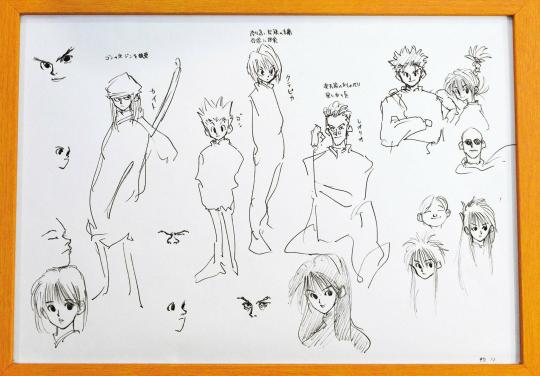
People have speculated that the woman next to Ging might be Gon's mother, however there isn't actually conclusive evidence of this--it's just a theory. It could also be an early design concept for Mito, Menchi, or one of the other female characters from the series, as the drawing isn't labeled with a name or description like some of the others. Or, she could be a scrapped concept even if she was intended at the time to be Gon's mother, as clearly this isn't finalized in any way.
You can read about this drawing a bit more here!
However, of course within the series itself we have no info on who Gon's mother might be, and Togashi did bother to include the Pregnancy Stone card:

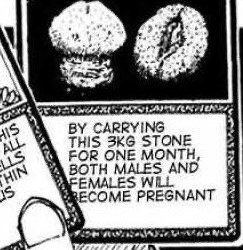
Now, an interesting connection with this is that Togashi is known to have read the BL manga Patalliro!, as he based Hiei's hair off one of the characters, Scunky:
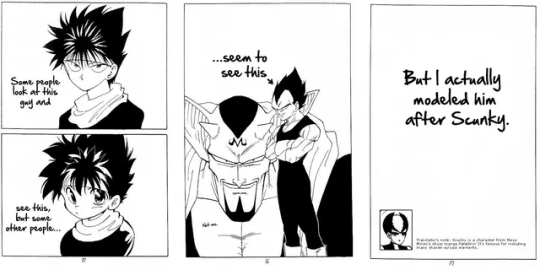
(From a doujinshi Togashi released, Yoshirin de Pon!)
There is also an unconfirmed but very reasonable theory that Killua may have been based in part of the character Maraich from Patalliro!, as the basis of both characters is similar and we know for a fact from the above image Togashi has read Patalliro!.
Now, how does this connect to the Pregnancy Stone theory? Well, Patalliro! also has mpreg as part of its storyline (with biologically male Maraich getting pregnant twice through unexplained means, with one of these pregnancies leading to a son), and considering Togashi may have used other elements from Patalliro! as inspiration... You can see where I'm going with this. I do think it's interesting he put the Pregnancy Stone card in the series to begin with, and there's also the Panda Maid card ("excellent at taking care of human children"), and Ging has used a panda plush as a substitute for himself in the Election arc. Coincidence? Hmmm...
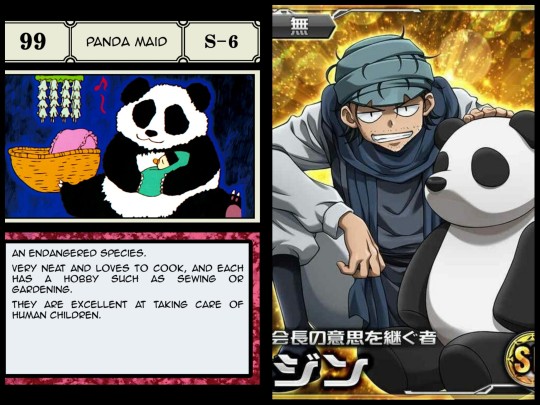
Image taken from this post, explaining more about the Pregnancy Stone theory.
My personal feelings now that I've laid all this info out are basically... I've talked a lot about how intentional Togashi's storytelling is and how much attention he pays to things, so I think he planted this knowing people would consider it a possibility, at the very least. We don't have any other theories about Gon's mom that have this much to go off of. It's possible he will reveal more info eventually and either make this more likely or explain Gon's origin in some other, totally different way, but for now I think this is compelling--there are enough pieces that it is a legitimate possibility.
I'm not someone who is interested in mpreg (or any kind of preg, for that matter, LOL), so I don't spend a lot of time thinking about this whole situation or the mechanics behind it, but I do think it would be pretty hilarious if this does canonically end up being Gon's origin story after all. Just such a wild way for Gon to come into existence. It'll be interesting to see if we ever get answers with regards to who/where Gon came from, whether it's by Pregnancy Stone or not.
It's a fun topic because it seems so goofy and farfetched initially, but the more you look at it, the more it's like, "Actually..." 🤔
(And thanks again for the review, my apologies that it took me a while to reply!)
92 notes
·
View notes
Text




ㅤㅤㅤㅤㅤㅤㅤㅤㅤㅤㅤㅤㅤㅤㅤㅤㅤㅤㅤ━━━━━
ㅤㅤ𔓘ㅤㅤㅤMy DMs are always open to talk
ㅤㅤㅤㅤㅤㅤdon't be shy to message me anytime. :)
ㅤㅤㅤㅤㅤㅤplease use tone tags when interacting
ㅤㅤㅤㅤㅤㅤwith me ♡ ty.
ㅤㅤㅤㅤㅤㅤㅤㅤㅤㅤㅤㅤㅤㅤㅤㅤㅤㅤㅤㅤㅤㅤㅤ
𝐀𝐛𝐨𝐮𝐭 𝐌𝐞. ❀


ㅤㅤㅤㅤ ㅤHi, im Violet, and I'm Dead. Boo.
ㅤㅤㅤㅤㅤㅤㅤㅤㅤㅤㅤㅤㅤㅤㅤㅤㅤㅤㅤㅤㅤㅤㅤ

Hi, Im Violet, and I'm 18+, ORPHAN, Please ask for my age in DM. Thank you ! I'm a She/Her, but I'm comfortable with any pronouns. I'm dating @solarmoontoast . I'm also a founder of the band called 'The Nomads' and the lead singer. I am an INFP-T, my house is Slytherin, my cabin is Cabin 5 Ares, and my Zodiac sign is a Gemini. I am also a Semi-Literate Roleplayer, and I'm dead. lol.
ㅤㅤㅤㅤㅤㅤㅤㅤㅤㅤㅤㅤㅤㅤㅤㅤㅤㅤㅤㅤㅤㅤㅤ

Likes
Shows
American Horror Story, Breaking Bad, Tokyo Ghoul, NANA, Junji Ito, Bungo Stray Dogs, Skins, Euphoria, Chainsaw Man, Bridgerton, Hannibal, 13 Reasons Why, Mandela Catalogue, Happy Meat Farms, Local 58, Marble Hornets, League of Legends: Arcane, What We Do In the Shadows ...
Movies
Scream, It, The Shinning, The School for Good and Evil, Heathers, Mean Girls, Wild Child, Jumanji, Sherlock Holmes, Enolma Holmes, Girl Interrupted, Twilight, Blade Runner 2049, The Perks of Being a Wallflower, All The Bright Places, The Breakfast Club, Thirteen, Harry Potter...
Musicals & Plays
Heathers, Be More Chill, Harry Potter Cursed Child, Beetlejuice,...
Books, Comic Books & Mangas
The Stranger, A Little Life, The Idiot, Inferno, NANA, Junji Ito, Chainsaw Man, Red Hood & The Outlaws, The New Teen Titans, Portraits of Dorian Gray, Harry Potter, Percy Jackson, Sherlock Holmes
Videogames
Left 4 Dead, Silent Hill, The Last of Us, Fatal Frame, Roblox, God of War, Undertale, Five Nights at Freddy's, Legend of Zelda, Life is Strange, Cyberpunk 2077, Mad Father, Sally Face, Alice in Madness, Franbow, Little Misfortune...
Music Artists
Mirah, Rob Zombie, Feeding People, Arctic Monkeys, Melanie Martinez, Gun N' Roses, Rolling Stones, The Kinks, The Strokes, Hole, Nirvana, Deftones, Panic! At The Disco, The Clash, The Killers, Hole, Radiohead, Chase Atlantic, The Neighbourhood, The Weeknd, Poppy, Mars Argo, Blur, Slowdive, Soundgarden, Ramones, Wisp, Strawberry Switchblade, Maneskin, Muse, Ice Nine Kills, Insane Clown Posse, Sleeping with Sirens, Joy Division, Sonic Youth, The Beatles, Pierce the Veil, Alice in Chains, Bikini Kill, Feeding People, Mother Mother, Paramore, My Chemical Romance, Ayesha Erotica, Ashnikko, Avril Lavigne, Three Days Grace, YUNGBLUD, Lil Peep, Kendrick Lamar, Pixies, Mazzystar, The Cranberries, David Bowie, Peneloppe Scott, Pearl Jam, Vocaloid, Widowspeak, The Smashing Pumpkins, Buzzcocks, Sex Pistols, The Smiths, Morrissey...
Artist
Gabriel Picolo, Michael Angelo, Carravagio, Salvador Dali, René Magritte, John Everette Millais, Federico Ferro ...
Authors
Edgar Allen Poe, Fyodor Dostoevsky, Brothers Grimm, Albert Camus, Franz Kafka, Sigmund Freud, Friedrich Nietzsche, Karl Max, Jane Austin, Virginia Woolf, Osamu Dazai ...
Dislikes
Loud Noises, Assholes, Narcissists, Egotistical People, Crowded Places, Musical Snobs
𝐒𝐨𝐜𝐢𝐚𝐥 𝐌𝐞𝐝𝐢𝐚𝐬
Discord:
Instagram:
Twitter: cxndiedvi0lets
Tiktok:
Spotify: TheGhostofMyFormerSelf.

Tags
Violet Harmon Content: #candiedviolets
Personal Blogs: #ghoulblogger
Travel: #broomstops
Reviews: #cauldroncommentary
Asks: #1-800-necromancy
Poems: #theravenspoems
Music: #hauntingharmonies
Food: #forbiddenfruit
Art: #graveyart
Fashion: #witchywardrobe
Memes: #rollingoffthegrave
Writings: #mourningdoveliterature
Vents: #silentviolent
Paranormal: #onlyphantoms

#ahs murder house#murder house#lana del rey#american horror story#violet harmon headcanons#violet harmon#violet harmon exacts#taissa farmiga#evan peters#ghoulblogger#Spotify#gaslight gatekeep girlblog#just girly things#im just a girl#girl blogger#girlblogger#cinnamon girl#girlblog#girlblogging#hell is a teenage girl#girl interrupted#gaslight gatekeep girlboss#girl blog#mean girls#girl interupted syndrome#girl hysteria#girl thoughts#american horror story murder house#esoteric#bio
140 notes
·
View notes
Text
Ten Manga I Think They’d Enjoy #2

Lucifer
He likes manga that reads like classic literature, dark stories, mysteries, psychological stories, and occasionally something sweet or cute
Children of the Whales, Mujirushi, PTSD Radio, Requiem of the Rose King, Shadows House, The Summer Hikaru Died, Togue Oni: Primal Gods in Ancient Times, Gachiakuta, Your Lie in April, Drops of God
Mammon
He likes stories involving his personal hobbies like working on cars, gambling, etc. he also enjoys funny stories and secretly cute romances or relatable romances
Play it Cool Guys, Bleach, Chibi Vampire, Daily Lives of High School Boys, Fire Force, I Belong to the Baddest Girl at School, I’m a Wolf But My Boss is a Sheep, My Monster Secret, Skip and Loafer, The Muscle Girl Next Door
Leviathan
Leviathan loves everything but he’s especially a fan of gaming manga, magical girls, monster girls, isekai, and the classics
A Centaur’s Life, Jobless Reincarnation, Yashahime Princess Half-Demon, If Witch Then Which, Banished From the Hero’s Party I Decided to Live a Quiet Life in the Country Side, My Clueless First Friend, Far-away Paladin, Geek Ex-Hitman, If the RPG World Had Social Media, Komi Can’t Communicate
Satan
Satan loves manga that reads like classical literature but he also loves stories about cats, dark mysteries, psychological stories and ones with characters he finds relatable
Case Study of Vanitas, Cat + Gamer, XXXHolic, Haunted Bookstore, Skull-Face Bookseller Honda-San, Vampire Library, Heavenly Delusion, I’m the Catlord’s Manservant, Infernal Devices, Library Wars
Asmodeus
Asmodeus mostly enjoys romance whether it’s cute and fluffy or extremely erotic
Nana to Kaoru, We Can’t Do Just Plain Love, We Started a Threesome, I Want You to Make Me Beautiful, In to the Tentacle Cave, Who Wants to Marry a Billionaire, Training Mr Sakurada, My Androgynous Boyfriend, Birds of Shangri-La, Interspecies Reviewers
Beelzebub
Beelzebub is a big fan of manga involving food but he also enjoys a good action adventure and sports manga
Crazy Food Truck, My Deer Friend Nokotan, One Punch Man, Restaurant to Another World, Let’s Eat Together Aki and Haru, How to Grill Our Love, Giant Spider and Me, Hajime no Ippo, How Heavy Are the Dumbbells You Lift?, Plus Sized Elf
Belphegor
Belphegor likes stories with relatable characters which can be hard to find but he also loves adventures, horror, and Slice of life; he’s a little all over the place
Servamp, Soara and the House of Monsters, Jujutsu Kaisen, Rurouni Kenshin, You Have No Human Rights, Uzumaki, SINoALICE, Gannibal, The Tree of Death, Dorohedoro
Solomon
Solomon loves compelling narratives, dark psychological stories, stories that take a deeper look a humanity and immortality, and one’s that involves demons/angels/sorcerers. He does also love cat books like Satan
Ancient Magus Bride, Blood on the Tracks, Bloody Mary, Of the Red Light and the Ayakashi, Demon Diary, Dr. Stone, Emanon, Jojo’s Bizarre Adventure, Magus of the Library, Mob Psycho 100
Thirteen
Thirteen is a little all over the place, she likes to see what’s popular but she also enjoys slashers, one’s that take a closer look at death and spirits, and dark romance
Duke of Death and His Maid, Executioner and Her Way of Life, Ghost Reaper Girl, No Longer Allowed in Another World, Versailles of the Dead, Your Turn to Die, Chainsaw Man, Your Letter, Solanin, Corpse Party
Simeon
Simeon enjoys reading manga that have some religious aspects, he likes ones about authors since they are relatable, and he enjoys some random ones here and there that are cute or funny. He’s also a sucker for a pure romance
Ceres Celestial Legend, Handa-Kun, A Witch’s Printing Office, Lord Hades Ruthless Marriage, Takopi’s Original Sin, Ride Your Wave, Haru’s Curse, Blank Canvas: My So-Called Artists Journey, Our Dreams at Dusk, Blue Flag
Raphael
Raphael canonically likes coming of age sports dramas. I believe he’s also he amused by one’s involving ant Christian aspects about angels and demons, heaven and hell. He also enjoys one’s that include his hobbies like security, military, and anything to do with fashion
Cheeky Brat, Waiting for Spring, Blue Box, Kuroko’s Basketball, Yowamushi Pedal, Ran and the Gray World, Mame Coordinate, Cinderella Closet, Kamikaze Girls, Anri a Shoemaker
Luke
Luke loves to try everything but his books are monitored to make sure he doesn’t stumble upon anything inappropriate for his age ana angel status. He loves ones about food, animals, adventure, and a good slice of life or 4-panel.
Cat Massage Therapy, Yu-Gi-Oh, Pokémon Adventures, Animal Crossing, My Little Pony: The Manga, Story of Seven Lives, Star Wars: Rebels, Dragon Ball, Disney Twisted Wonderland, Cardcaptor Sakura
Michael
Michael enjoys funny books, one’s that take a closer look at humanity and war, classical adaptations, and one’s involving angels and demons.
Record of Ragnarok, I Had That Same Dream Again, Skip Beat, Angel Sanctuary, Homunculus, The Ephemeral Scenes of Setsuna’s Journey, Alpi the Soul Sender, X, Ballad x Opera, Legend of the Nymph
Mephistopheles
Mephistopheles likes books that involve history, nobility, prestigious jobs, mystery, and equestrian sports. He also enjoys one’s about demons and servants.
Chronicles of an Aristocrat Reborn in Another World, Great Jahy Will Not be Defeated, Villains Are Destined to Die, Vinland Saga, Cantarella, Kingdom, Blade of the Immortal, Ron Kamonohashi: Deranged Detective, How a Realist Hero Rebuilt the Kingdom, Ajin
Barbatos
Barbatos prefers books that are dark and disturbing as well as insightful books on time, immortality, grief, morality vs law, etc.
Coffee Moon, Drifting Classroom, His Majesty the Demon King’s Housekeeper, The Maid I Hired Recently is Mysterious, Horizon, The Lady and Her Butler, I Sold My Life For Ten Thousand Yen Per Year, Homunculus, Parasyte, Yokai Rental Shop
Diavolo
Diavolo absolutely loves cute family manga, funny manga, one’s that involve demons and angels, cute romances, and exciting action and adventure. He isn’t picky and will read anything if it’s been recommended to him.
Correspondence From the End of the Universe, Soul Eater, Given, In the Clear Moonlit Dusk, Juana and the Dragonewt’s Seven Kingdoms, Terrified Teacher at Ghoul School, Thigh High, Delinquent Daddy and Tender Teacher, Hate Me But Let Me Stay, Hinamatsuri
#obey me shall we date#obey me headcanon#obey me lucifer#obey me mammon#obey me leviathan#obey me satan#obey me asmodeus#obey me beelzebub#obey me belphegor#obey me solomon#obey me thirteen#obey me simeon#obey me raphael#obey me luke#obey me mephistopheles#obey me barbatos#obey me diavolo#manga reccs#no manga has affected me like you have no human rights
139 notes
·
View notes
Text
Jelloapocaylpse and One Piece
So, there's this thought I've been having about gigantic franchises: any criticism against them needs to be taken with two specific grains of salt. First, people who dislike the franchise will be more annoyed by its flaws because of overexposure, and second, reactions to these criticisms will be overblown because there's so many more fans. I'm of the opinion that you shouldn't respond to criticisms of your favorite things if they're enormously popular, meaning I'll be more silent on negative reviews of things like Critical Role, One Piece and Brandon Sanderson's works than I would be for smaller things like Wayward Children, Grimm or The Craft Sequence.
But when these two grains of salt come together? Oh, boy. OOOOOOOH boy.
I love So This is Basically..., and have since I discovered the channel. A good chunk of my humor comes from the jokes in those videos, and even for something like Kingdom Hearts where it's negative, I still enjoy both the video and the franchise, so I've elected to let it be. But in his recent video on One Piece, while it was funny he got so many things seriously wrong about the series that I've struggled with whether or not to say something about it. I think the artistry on display in the video can get drowned out by the negativity being poured into it, and while I don't have much of a platform I can yell into the void like the best of them, and it's bothering me enough that I want to lay some things out.
So, for your discretion: a time-stamped review of Jelloapocaylpse's So This is Basically One Piece. I will endeavor to only time-stamp things I found wrong about the series. I understand jokes aren't meant to be taken seriously, but I think humor is revealing, and if we can dissect the jokes of the anti-woke crowd to find the ugly truth within, we can do the same to ourselves. And if I can shout out a more complicated thought about One Piece from a joke then I will, and even point out moments where Jello is right.
I will not talk about Brendan Blaber's personal life nor his anime work. I am aware of what happened with Lovely★Complex but find it immaterial to the video on his YouTube channel. Perhaps his motivations were dishonest, and that could explain his rampant dislike of the source material; at this time, I don't think it factors in, but if I'm proven wrong I will make an edit with the proper updated information. And, per a beef I have with the video itself, I also want to stress that you should not harass nor send death threats to people you dislike, especially about a piece of media. THIS INCLUDES ASSHOLES.
With that, let's begin. Video is included so you can follow along. There will be spoilers freely discussed; be forewarned. If I am wrong, chime in and correct me; I am not above mistakes.
youtube
0:08: This is a fun callback to the 4Kids dub of One Piece, which is widely reviled but for some small moments of genius.
0:11: an out-of-context, raving explanation of the worldbuilding, which is entirely correct.
0:38: Incorrect. The Grand Line is specifically written to be hard to get into and out of unless you have the tech for it. This is a big deal in both the manga and the anime and I don't know why/how he missed this.
0:50: This is a fan theory. I was willing to accept it but googling it turned out it wasn't correct. The following jokes require this to be true, however, so creative license applies.
1:06: Arguably true, and I say that because, while each of these characters technically has a different power, they're all used to manipulate the environment and stone like it's water. That's a thing and a theme in the series; Luffy even gets to fight Charlotte Katakuri, who has a similar Devil Fruit. Call it lazy, call it creative, it's debatable, and funny.
1:11-1:38: the following explanation is also true, but insulting. The boundaries between each Devil Fruit are more fluid than the initial system lets on, true, but as in real life aggressive categorization is usually incorrect and uninteresting.
1:43: The description of the fights applies less to One Piece than Shounen as a whole. You could be uncharitable and say it describes all fights, but I will restrain myself. A lot of fights do have an element of unpredictability to them; sometimes it's the randomness that feels realistic and other times it's Deus Ex Machina. You could argue the fights are more about the philosophical difference between the two (Sanji vs Wanze comes to mind) but it makes for long, drawn-out fights. I think most of the pacing problems come from the anime but I've been annoyed by the manga as well.
1:55: It is true that Robin doesn't get many fights, which is disappointing as a Robin fan. And I won't deny that sexism pervades the writing of One Piece when it runs unchecked. But I don't think the two are related; Robin's fights tend to be brutal and fast, and she deals more with grunts than generals. The exception is Robin vs Black Maria, which was Very Good.
But her focus in the story is less on fighting and more about archeology and history, and in that case she often reshapes the way we see the world with her investigations. Fighting ain't all there is to a Shounen series, and the wise reader remembers this. (this point copied wholesale from Anthony Gramuglia)
Obligatory "Yes One Piece is very long and I hope it ends well".
2:02: The espionage episodes are quite good. But I think this conclusion draws from the dislike of the adventure and action, so you need to agree with the first to reach the second, and I do not.
2:08: I had not realized how many islands were circles in One Piece so that criticism applies even if it doesn't mean anything for the quality of the series. But Punk Hazard isn't about stopping Smiley (who barely features) and I would argue that "natural disaster" doesn't apply to some of the threats the crew faces, and it's definitely not every arc.
2:24: only Punk Hazard was (half) on fire. Fires do happen a lot as a way to push tension but the arcs were flattened to make this point.
2:30: "from the jungle" is the best joke in this episode.
2:37: "Hit 'em with the poison that doesn't work!" happens a lot as well. It is often because the characters have to figure out a way around it, like other protagonists do during Good Fights.
2:46: This is a weird take. I know Zoro is an asshole but sexism was something he hated in his childhood and that disdain forms a big part of his personality. You could also call him Minority Hunter like the fanbase does, given he fights mostly black people.
2:52: Nami's not gay in the series, not explicitly, anyways. Alas.
2:56: God, to be a Sanji fan is to suffer. He has some of the best and worst moments in the series and the live-action series made him a bajillion times better.
3:15: good follow-up on a joke with a bad setup.
3:16: I'm annoyed Franky was removed from this. He's a lot of fun. And I'm also annoyed that you talk about Sanji's perversions but don't bring up Brook who is arguably worse in every way. These as well as Chopper and Jinbe get flattened for the sake of this video, and considering Chopper is my favorite Straw Hat this very much annoys me.
But he does make a point about these characters: Robin through Franky don't get to do as much throughout the series. They're often rendered as side characters who react to things instead of having their own arcs. For all that Thriller Bark was Not Great, Chopper was given an arc that ties very directly into who he is, and I'm saddened we didn't get something like that again until Wano.
3:21: The characters have personality, it is just now shown in this video. Usopp is not given a description and Nami is summarized as "lesbian" with nothing else of their character depths.
3:26: again, the best joke is the jungle joke.
3:39: I am not certain we're supposed to like Aokiji. He does some pretty heinous things throughout the series. Garp is a more-interesting case, in that his loyalty to the World Government is treated as his greatest flaw, but he's also an asshole. It's almost like he's a very complicated character or something.
3:47: This is the part that I kept coming back to, the part that's most insulting. I am bad with names so I admit I had to google this fish-man's name, but his name is Macro, he was a member of the Sun Pirates and he didn't keep slaves. The Sun Pirates especially freed any and all slaves they came across because they were also enslaved. Arlong did keep slaves but he was not enslaved himself, and the continuing stain of racism and slavery washes out over the rest of the series itself almost as if it were good or something. Out of all the things to get wrong, this one was the most egregious.
4:00: The Marineford arc was VERY LONG. A lot of stuff happened and it affected the pace quite a bit. The dig at the author is unwarranted.
4:07: FROM THE JUNGLE BA-
4:15: I'm torn on this complaint. On the one hand, subtle foreshadowing is usually the way to go when it comes to announcing what is going to happen. On the other hand, you can easily forget a lot of things that happen in a single narrative so sometimes twists come out of nowhere.
However! This complaint is mitigated by the fact that the series will readily bring you up to speed on context whenever it's necessary. Take that as you will.
4:20: Localization is a Thing™ that happens and translation hasn't always been the best. I first learned the word "nakama" from Japanese because of a fansub of this series that insisted it wasn't just "family". I am also annoyed by newer chapters that insist on calling the swordsman "Zolo", and these issues extend to the fan wikis. This has nothing to do with the show or manga, however.
4:33: There are a LOT of characters, true. Whether or not that is too much is debatable; they are drip fed to the reader over the course of all the chapters, and even if there are twice as many characters as chapters (there are not) that's two characters per chapter to introduce. That's not a lot for an audience to read; if you've gotten through Wheel of Time you will be fine, but this ties into a latter issue I'm about to bring up.
4:47: I'm almost certain these characters were chosen at random. On a whim, I decided to return the favor and pick a character at random to defend its inclusion. That turned out to be Pekoms.
Pekoms is a character in Big Mom's crew, loyal but deathly afraid of her. He's defined both by this bond to Big Mom as well as to his Mink heritage, and he takes pride in both. It's only when he learns of the Straw Hats' defense and salvation of the Mink Tribe that his courage starts to grow to outweigh his fear, and he eventually turns on her in response to the sacrifice of a friend of his, demonstrating the themes of the Whole Cake Island arc: a family bound through fear is a temporary measure, and it will fall apart when something better comes along.
I bet you could make a defense of just about any character he removed, even characters that are bit players. That's the thing, too: complaining about "too many characters" ignores the fact that sometimes, the guy who gets one line also gets a name. A stage play should be stripped down to pure essentials, not so much with mediums you can edit.
And fuck, he cuts out Yamato?! The best guy around?!!
5:07: It's very strange that he says the Straw Hats don't have any meaningful dynamic with each other when the #1 thing people keep asking for is downtime so these characters can hang out and interact almost as if their dynamics are what carry them through the arcs. I mean, it has been a while since some characters interacted, true, but remember: there are 10 Straw Hats on the crew. That's 45 different interactions that are possible. There's, sadly, not gonna be enough time for Robin and Jinbe to sit down to tea with everything else going on.
(Also I know that in Wheel of Time (the closest approximation in length) Rand, Mat and Perrin have a wonderful dynamic and then don't talk for several books. Sometimes the plot happens, but I don't know if people hate this part of the series so this might just be me; I stopped reading during The Path of Daggers or The Winter's Heart, I'm not certain. I remember being annoyed by Tuon a lot)
5:26: I'm going to divide this between the two questions people asked on SBS. None of what happens with Fuckass Joe in this question is relevant to One Piece as a whole because it doesn't happen in the story proper. But the way the video frames Oda's relationship with his editors is weird.
5:47: I'm gonna be honest this is a really weird question to include in SBS. Whoever sent it in definitely has some things going on, and while Oda wasn't responsible for it (and he answers the question with annoyance and confusion) the fact it was included at all speaks to the priorities of the people writing it. Again, this is about SBS and not really relevant to the manga as a whole but I think you can absolutely be critical of this with Oda.
5:54: There's three complaints in here in rapid succession, so I'm going to go through each:
"Breasts grow larger": absolutely a thing that happens. It's a well-documented annoyance in the fandom at this point, and hard to miss.
"Negative space grows rarer": I'll be honest, I didn't notice this as a problem. So I went back to the manga and re-read chapter 1, chapter 1133 and chapter 566 (about halfway through). In the first chapter, there is a lot more negative space in the panels so you focus more on the characters, and there's a lot more characters and background details in the latter chapters, but it's not hard to follow even still. So I'm not certain this is an issue, but it could be an eyesore; adding detail is not always to the good.
"Oda doesn't credit his assistants" I didn't find the names of his assistants through Google. The fact it is hard to find is telling, either for Oda or search engine optimization. In either case it's nothing to do with the manga. It should definitely be easier to find these names.
6:07: The sketchy art had a purpose in a flashback, showing someone losing memories (and on a more-meta level I think Oda had a health emergency... correct me if I'm wrong). I don't think the artwork has changed overmuch from the beginning, and there's a conversation to be had about the changing amount and quality of the details, but given it is shown that they're specifically referencing that kind of art I wanted to respond to that directly.
And the pot-shot at the anime is more deserved. The fact it's weekly means quality can vary wildly and characters are often drawn off-model in a way that's meant to be sexy but doesn't look very good. (I couldn't find it, but there's a specific part where Nami gets injured and scuffed up, and the anime adapted it more sexually than the manga made it. Not that it was nonexistent, mind you. This part is a "trust me bro" more than the others so please keep that in mind).
6:17: The pacing in the anime can be quite bad. The joke with the water slowly turning yellow is also quite funny.
6:38: This is debatable. The story has happy and sad moments like most good stories and it's an adventure story, with a focus on fun. But the story is also willing to leave you with strong negative emotions and just deal with them, the backstories being the most notable examples of characters dealing with trauma.
6:46: This criticism is overblown but not incorrect. Pell should have died from that explosion and I stand by that, but no consequences to anything? There are whole chapters where the balance of the powers of the worlds are shifting and these consequences play out. Whole arcs are built from the consequences of of the death of Whitebeard alone and, as Anthony Gramuglia pointed out in his stream (I'm still watching it to conclude its accuracy) if the manga has intense foreshadowing and knows where it's going that goes against the "no consequences" criticism. (again, thank you Anthony Gramuglia for this note)
6:54: Uta is from a movie that is non-canon, even if she exists in-story. It would be unreasonable to note any criticism of the story from One Piece: Film Red because it's unreliable as a foundation.
Yasopp leaving Usopp is something the fans have complained about for some time now. At this moment we don't know if he had a good reason for leaving beyond heeding the call to adventure, but I know I, personally, think it was a dick move.
7:03: I find this next part disingenuous, for all the potshots Jello takes against Oda before and after. It's also unrelated to the story as a whole (mostly) so I'll be skipping through it.
7:26: I think this criticism stands. Oda is very weird about women in the story and tends to draw them a specific way (thin waist, large bust, tall and lithe). This doesn't stop almost all of them from being interesting characters, mind you, but it's something to keep in mind as you read the story.
Also, if you were going to criticize Oda for Ephebophilia (sexual interest in mid-to-late adolescents, according to le Wikipedia) in his story, that's great, but if you're going to take potshots at him why don't you also mention his friendship and defense of Nobuhiro Watsuki, writer of Rurouni Kenshin and most-known for possession of child pornography? Why drag the family into this when they have nothing to do with Oda's behavior or predilections?
And that's that. I won't be doing this too often (I am a writer and a critic, not a drama channel) but that specifically left a bad taste in my mouth I wanted to get out. Again, if there are any mistakes I will be calling them out in the edit.
One Piece means a lot to me. I've been following it since I was a tween, and it was the first series I read without my parents' permission (oddly enough, my very conservative mother also though the women were too sexualized... on episode 92, before it got so much worse) because I loved it so much. And even now as an adult I find it an old reliable that makes me happy. I try not to be blind to its flaws; I can see the sexism for female characters and character design, the way Oda writes gay people has improved but isn't perfect, and his examination of racism is hampered by not having stories to draw from about it. But it's a long, wonderful series that I can heartily recommend to anyone who enjoys adventures and themes of freedom, family and fun.
So This is Basically... is a series that always manages to make me laugh, even in episodes I dislike. I say "Sora, become a beekeeper!" to myself all the time, and the specific way Jello says "garbage" in the RWBY video sticks with me. But if you engage with the media he talks about you can see the cracks; it's the CinemaSins problem, disguising criticism as jokes and jokes as criticism, never taking a firm stand on either.
I hope both these series improve. I hope we look back on this video as a fluke rather than the standard. I'd like to continue to enjoy Jelloapocalypse in its purest form. But this whole thing has been uncomfortably revelatory to me, and I will keep my eyes open and my mind sharp.
EDIT: I finished watching Anthony Gramuglia's video on the subject. I don't 100% agree with his takes (in particular the speakers' disdain the humor, which I enjoy quite a bit) but he and his guests go into more analysis than I do, at times coming up with ideas I hadn't considered (as mentioned in my previous notes) and at times reaching a bit. I still think it's quality analysis on why Jello is a terrible reviewer in a number of key ways.
EDIT2: I did eventually get a look into what all happened with Lovely★Complex, but in the process I also found a video that more formally breaks down the flaws of Jello's arguments, even before his video was controversially-received. I'm including it here for anyone who only has 30 minutes for this kind of thing.
youtube
44 notes
·
View notes
Text
youtube
DR. WHAT?!! Dr Stone Season 4 Episode 4 Review
#dr stone#anime#manga#otaku#manga anime#youtube#anime review#dr stone senku#kohaku#dr stone taiju#dr stone xeno#dr stone stanley
6 notes
·
View notes
Text
Bungo Stray Dogs S5E7
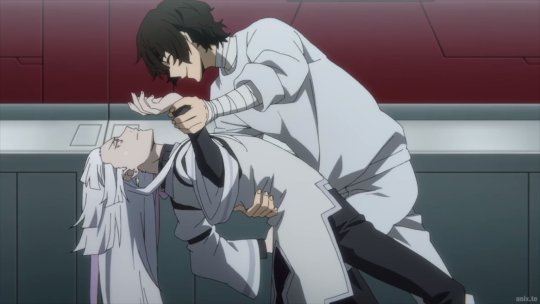
I don't know what to make with this episode that's just pure chaos and disaster provided by Dazai. While the rest of the Detective Agency is trying to prevent a vampire outbreak, the dumbass is in prison dancing and exploring.

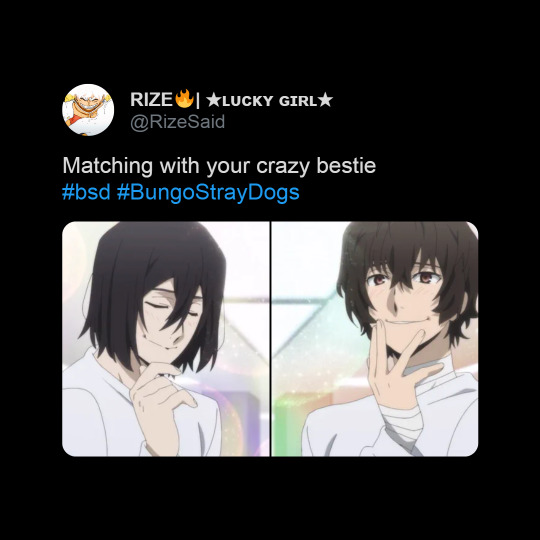
It's like having your most reliable friend in the most needed situation but only dumb comes out. And you're not sure if you're dumbing it down or you're realizing he's just pure dumbass but you love.
Bra-chan was ready to give in. I don't blame him. He got his Spotify and someone to carry him. That's life.
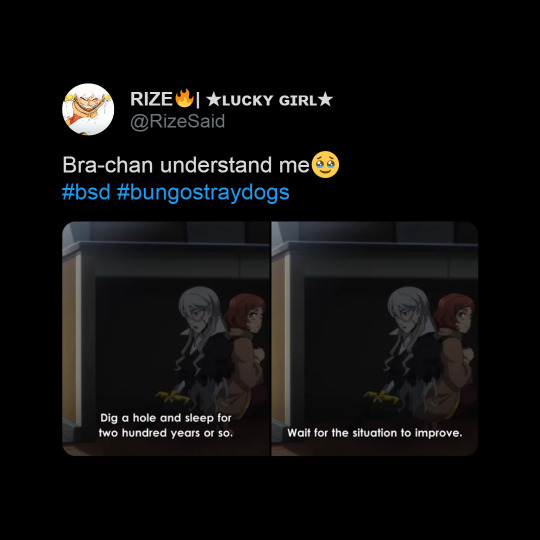
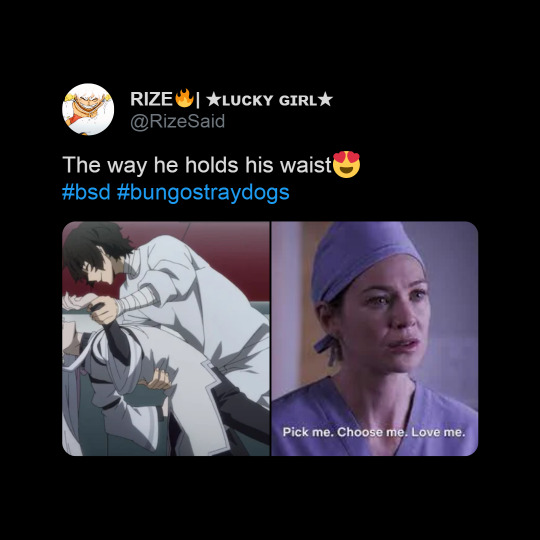
I wanted that dumb suicidal maniac to hold me
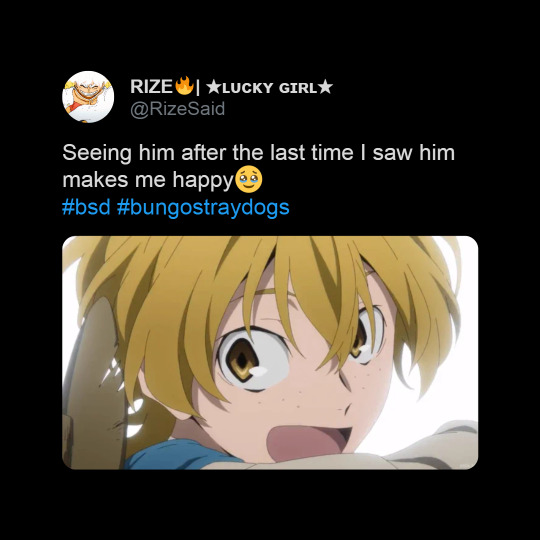
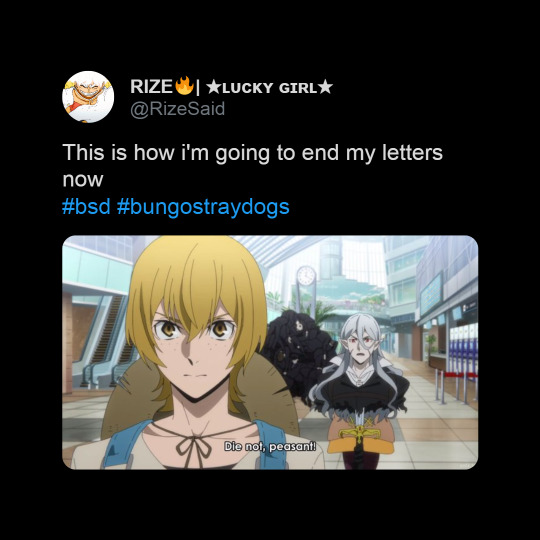
After the shit he went through when the Detective Agency was falling apart, I was happy to see my little farmer boy again.
But then,
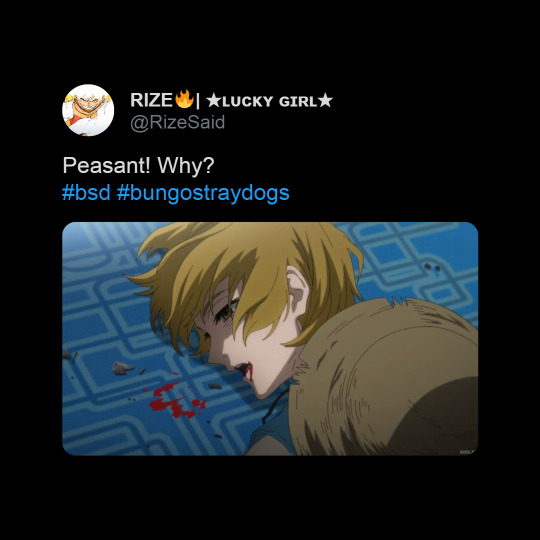
I know he's going to be okay since we have Yosano but why must they hurt my farmer boy. The detective agency was only his side job. He's basically a part timer. We don't hurt part timers. Just fully fledged emplyees
The next episode is going to be good. People changing sides. Chuuya vs Dazai (maybe) Or Dazai may just have a dance party in prison or some other shit
#anime#anime and manga#seinen#anime recommendation#anime review#anime reaction#what i'm watching#One Piece#My Hero Academia#MHA#BNHA#Boku no Hero Academia#Jujutsu Kaisen#JJK#Attack on Titan#Shingeki no Kyojin#Bungo Stray Dogs#BSD#Fairy Tail#Dr Stone#Spy x Family#Hell's Paradise#jigokuraku#Chainsaw Man#Jibaku Shounen Hanako-kun#Oshi no Ko#Mashle#Kimetsu no Yaiba#Demon Slayer
7 notes
·
View notes
Text
Ranking and reviewing the musicals I saw in 2024!
Starting this in April so I don't have the freshest memory for the first two but the rest will all be done as soon as possible after I see them!
Six - Already seen this show twice but its still such a cool experience! Last time I went to see it was pretty close together so it was the same cast for both but this time it was obviously a different one gchkfkjgv- I think I preferred the cast I saw before though, this one wasn't bad at all they just had better chemistry. Also this time I genuinely didn't care for Heart Of Stone. I hate it on the soundtrack so I was expecting to hate it on stage but when I went to see it the first two times I ADORED it. I thought it just couldn't be done justice by the soundtrack but now I think its just one that is either incredible or boring, no in-between. Her little speech before the song almost made me cry though so it's not that she was a bad actor, I just think she's better at acting than acting through song. ANYWAY ENOUGH ABOUT HEART OF STONE a really interesting thing about going to see a show again a few years later is that you see what lines they've changed and added (and also what lines were complete lies like no I don't remember you from my GCSEs yall have not been mentioned once fthdrhutfxhtc/silly). Idk its just cool to me seeing how shows change over time. Also the actors weren't all negative compared to the ones I've seen before! This Katherine Howard was INCREDIBLE. I fucking ADORED All You Wanna Do, it's not my favourite song but it's DEFINETLY my favourite one on stage GOSH she smashed it out of the park. Absolutely loved every second.
Rating 7/10, would be higher but seeing a better version of this show put this version down for me. Still really fun though!!!!
Your Lie In April - I've spoken about this one before so I'll keep it brief, really good show, was very cool to see the first English performance of it and I geeked out hardddd during it. Was incredibly funny which was surprising given how sad of a manga YLIA is but it was very pleasant still. Watari was the best character they gave him all the best jokes and you could just tell his actor was having an absolute blast playing him he was LOVING it. But on the negative side, there was a lot of pacing issues in the second act and some lines were really awkward to the point people were laughing at lines that were meant to be sad. I don't think it's the actors fault, I think the book just could've had more work done on it, it mightve been TOO directly translated. Also the pacing issues could've been at least a little helped by getting rid of the 8 minute scene were Kousei practices playing his song like it was cool but did we really need that when you CUT THE FINAL DUET??? LIKE YOU COULDVE KEPT THAT AND JUST INCLUDED KAORI I COULDVE FORGIVEN THE PACING ISSUES IF YOU DIDNT CUT ONE OF THE MOST IMPORTANT SCENES IN THE STORY- oh and there were a few too many songs like I love myself shows with 50 songs on the soundtrack (Hamilton and Next To Normal my beloveds) but the pacing issues could've been really helped by cutting one or two of them, as good as they were. The show could've really been helped by being just a little bit longer.
Rating 7.5/10 Still really enjoyable show and I really hope to see it again because I'm sure the quality will improve!! But as it is its not the greatest it can be even though the potential is there. The only reasons it's higher than six is because Watari was fucking hilarious, the scene where Emi and Takashi show up on bikes for NO fucking reason, the songs being bangers that I really want to listen to again cast recording when, and Young Kousei started break-dancing during the bows it was incredible.
Waitress - I wasn't going to include this one since it's not a physical performance but like. I'm gonna do it anyway bc there was only one showing of it at the cinema so like its basically just as cool right?/silly And anyway proshots are the only way I can see Broadway shows so this was only my second exposure to one and DAMN AM I JEALOUS OF U AMERICANS (my first was Hamilton's proshot btw which doesn't really show the full extent of Broadway since its one set throughout the whole show but that one is still amazing ofc)
The set design? Fucking IMMACULATE it was incredible GOD. Literally some of the coolest sets I've ever seen in my entire life (ngl probably THE coolest) and the fucking PIE FRIDGES ON EITHER SIDE OF THE STAGE??? LIKE????? HELLO????????? Making that many props must've taken forever what the fuck. Just the props and sets in general astounded me. I've done shows with props and sets before and I've seen them with props and sets before but never have I seen so many, not to mention how gorgeous they all looked. Genuinely wondering if some of the pies were real or if they were all props bc they were legit eating them like god those must be a pain to make for 8 shows a week-
I adore the characters and plot. I'd already seen the movie (which isn't a musical, was very disappointed when i discovered that lmao) so I had a vague knowledge of what I was going into but it still blew me away. I was genuinely sobbing throughout the entire show I'm not even joking 😭 I'd only heard a few of the songs since I had to sing them for my Musical Theatre grades but hearing them sung on stage gave me fucking goosebumps still, ESPECIALLY Sara Bareilles' songs. She's always been my favourite Jenna so it was amazing seeing her perform it. There's just something about seeing someone perform songs they wrote that destroys you so much more. However, some of the songs I wasn't really as invested in, the lyrics weren't sung very clearly and it made it difficult to follow along. I'm going to listen to them on the soundtrack at some point but I decided not to do so until I wrote this review as it's for this specific production and not the musical as a whole.
Without spoiling it, a part of the ending was the only thing I personally had an issue with, outside of the song issues I mentioned. I understand why it had to happen for the story and characters and I think it's cute but PLEASE. I WAS SO INVESTED IN THAT PART OF THE PLOT PLEASEEEEEE. It partially makes me question why that part of the plot really happened??? I don't know I guess it could just be me not being knowledgeable on that sort of thing and I can think of a few reasons why they went that route but its still weird to me, especially after this one scene that made me so certain it was going to go in this one direction.
9/10, incredible musical, definitely in my top 5 (for now), but some story and song issues made me push it down a bit.
Hamilton - ALEXANDER HAMILTON!!! I've been waiting to see this show for so long yall don't even KNOW. I've obviously seen the proshot like a shit ton but as yall know that isn't comparable to seeing it on stage. Ofc having already seen it so many times, the impact was lessened but I'm not gonna hold it against this show. When it came to Six the versions I'd seen were on very even playing fields but you can't compare a Broadway pro-shot with the original cast and the writer of the show himself to a UK tour that has only just switched to a new theatre (not that the UK tour was bad in any way shape or form, it was just obviously smaller scale which is completely fair).
First off, let me say, Peggy/Maria was INCREDIBLE. God her voice was fucking gorgeous, the fact that she's only in about 3 songs is criminal and her acting was so amazing. I would love to see her in a show again because I need to see more of her. Layfette/Jefferson was another highlight, god I adored him, he was incredible as Layfette but he turned it up to ELEVEN as Jefferson and I was immediatly hooked whenever he came back on stage, his movements and his acting and vocals were all so animated and it was so goddamn cool to see. The way he says "I tried :(" in *last song* will be stuck in my brain foreverrr.
I actually got a picture of the set before the show and just LOOK at how gorgeous this is

Like HELLO??? U cannot look at that set and tell me it isn't the coolest shit you've seen in your entire life. This is a good time to mention that I had STALL TICKETS TO THIS. I didn't know until we sat down bc going to this was my 16th birthday present from my Grandma (I love her so so much) and all she told me was that we were going to Hamilton nothing else WACHJXFHG- so yeah that was absolutely insane. I got a great view as well so YIPPEE!!! Definetly elevated my experience as I was far enough from the stage where I could see at least a good deal of it and close enough where I could see the expressions and it was SO COOL.
Also before I get onto problems I have to say that this show had possibly the FUNNIEST 9 year old Phillip performance I've seen it was fucking incredible, he like jumped up and WRAPPED HIS ENTIRE BODY AROUND HAMILTON AND I WAS JUST DYING WAVVGHJFGH- I thought the thing of a grown ass man playing a 9 year old was funny before but this production took it to a whole other level literally had my head in my hands laughing so goddamn hard it was amazing.
I think my biggest problem with the show was honestly Burr. Like I wasn't the biggest fan of Hamilton himself but he absolutely had his moments, especially when he was singing (and in Farmer's Refute he was so fucking funny in that song). And The World Was Wide Enough was incredible, honestly I think he really shined in Act 2, he was amazing in that, Act 1 was more of the issue. But Burr I didn't really like for most of the show. Not as a character because Burr is absolutely one of my favourites, most of my top 5 songs from this show either feature him or are only him (the only outlier being Say No To This) so it was relatively disappointing that his performance didn't click with me, especially since Burr is such an important character. I will say that The Room Where It Happened was SPECTACULAR but otherwise yeah I wasn't a fan. My favourite song in the show is Dear Theodosia and the fact that that was probably one of my least favourite moments in this specific production says a lot. He did have his moments like Hamilton's Act 1 performance did, but otherwise I was not a fan. Also I saw more of Burr in Laurens' actor than I did Burr's so like. Yeah. He's not a bad actor or singer I just don't think he's that great of a Burr.
Eliza is kind of a middle ground for me, because she had moments where she was absolutely incredible and then moments where I was just like hhhhhhh. Her actress had a gorgeous voice and it was very distinct, like whenever the ensemble sang you could pick her out easily, I love her voice so much. But early on in songs like Helpless her voice had a tendency to sound very nasally and pick me-ish (idk how else to describe it), especially on the "I Do's", like Helpless had me WORRIED. But she really does improve as the show goes on and she grew on me a ton. It's just early on where I wasn't that keen on her. Songs like Burn and *last song* are where her voice really shined, god those were absolutely incredible. Also I will say, she is a *very* new Eliza, the old Eliza's run ended just before I saw it (which I was pretty sad about ngl because I was so looking forward to seeing her) so I will give her the benefit of the doubt because for one of her first shows as Eliza she did a fucking amazing job despite certain bits at the start being not the best.
To end on a more positive note, I'm not much of a dancer (leg problems ayyyyyy) so I can't speak too much on the choreography but it was absolutely breath-taking, anyone who's seen Hamilton knows how incredible the choreography is no matter who's directed it but god I adored it. The movement really does make this show I swear. I wish I could've watched all of the ensemble do their thing the whole way through because the Hamilton ensemble is always an absolute highlight of the show and they all did an incredible job god I wish I could watch just that choreography again I'm in LOVE with it all.
Another 9/10, Burr's performance would've tanked it a bit more but everything else was so incredible that I really can't score it too low, if it weren't for Burr I probably would've liked it more than the proshot and for people who've seen the proshot you know that's a LOT to say. Brilliant show, would love to see it again. If the Burr changes I will be FIGHTING for a ticket because that's bound to be a life changing experience.
Bonnie And Clyde - Is a show I was going to see but the UK tour got cancelled due to poor ticket sales :( I'm really bummed about it bc I legit had front row seats to it. But we used the refund to get tickets to Chicago next April so yippee!!! Sad I can't yap about seeing it in person but I hope to watch the proshot at some point!!! I sadly haven't gotten around to it at the time of finishing this post but Jeremy Jordan is in it so I'll get around to it eventually.
Dear Evan Hansen - Okay writing this over a month late bc I wrote the Hamilton one in fucking June and I went to go see this in October so I straight up forgot I was doing this 😭😭 but yeah it's November now. The day of me seeing Book Of Mormon is closer than the day I went to go see DEH. Wild. So yeah bc of this, this section may not be as in depth as the rest due to it having been so long BUT!!! I will try my best!!!
First things first, I was SCARED for this show. Hamilton showed me what having an actor who didn't work for the role in one of the most important roles of the show could do, and given Evan is around ALL the time I was begging he would be good. And guess what? He was... AMAZING‼️‼️ Absolutely loved him, genuinely I would kill to see him in more performances because he was incredible. I doubt that would happen bc he's from a different part of the country from me but honestly he deserves to go on as many tours as he damn pleases. Honestly the entire cast was solid, there wasn't a single actor I didn't think fit their character, they were all really well cast. Zoe had a few weird moments here and there but it was literally opening night in a completely different venue, I cannot give two shits, go girl go u slayed.
Connor was definetly my favorite character, I was most excited about this because of him as the soundtrack doesn't really give you much Connor Content™️. As someone who's read the book though I genuinely wish there was more of him (I know the book is based off the musical but it's way better fight me). Connor is just as much of the main character as Evan is, and whilst I know that trying to squeeze in more character stuff with him would've been generally very difficult I kinda just wish he was lurking on stage at times, would've been a good metaphor for Connor's looming prescence over Evan that he self-imposed and now he's having to deal with the constant consequences of. We do get a few moments of Evan's version of Connor talking to him (or singing with him in the case of Sincerely Me, my second favorite song here as Connor's actor was brilliant, it was staged amazingly, and ofc its the only comedic song in the show so you're bound to get a lot of enjoyment out of it), but I wish his presence were more frequent, its a musical man get creative!!!!
The set was incredible, genuinely they knocked it out of the park, especially given it was a relatively small venue, at least compared to some of the ones I know it was performed at previously. They had moving kitchens and different bedroom sets and it was sickkkk!!!!!! Straight up loved the set design. And the songs were gorgeous, everyone had a beautiful voice which honestly should be expected given it was a tour but I already told yall about Hamilton, and tbf I have seen a few shows where the actors take an entire act to start sounding good 😭😭 (Veronica in the performance of Heathers I saw at this same theatre I am talking to you I hated her in the first act and then suddenly in act 2 she blew me away like GIRL WHERE WERE U HIDING THAT VOICE HUH????) So this was just genuinely a really cool thing to me, idk how they can sing so incredibly for 2 hours straight its mesmerising.
The best part about this show was being able to see my favourite song performed though because it was CUT OUT OF THE MOVIE. THE MOST IMPORTANT SONG IN THE SHOW (IN MY OPINION) WAS CUT FROM THE MOVIE. Good For You fucking SLAPS and I was estatic to be able to see it in its full context and glory. Evan is a sympathetic character but he's also a character that NEEDS to be held accountable for his horrible actions and the fact that the movie barely did that has always pissed me off so thank you performance of DEH in its best form you have avenged me.
8/10, I generally still had some issues with it, I dont think this show is the best it can be (I still kind of hate the ending) and I probably would've had more negative things to talk about if I wrote this review earlier, but still a great show! Evan's actor should be given as much work as humanly possible I will FIGHT FOR HIM.
Book Of Mormon- OKAY SO UM. ITS BEEN A MONTH AGAIN. ITS LITERALLY 2025 NOW. I was finally gonna write this review after my birthday bc I was hella busy before and then I got really sick. Oops! BUT!!! I CAN YAP NOW!!!
This is one of my favorite musicals, straight up no lie. I was listening to the HELL outta it after I went to go see it, I listened to Spooky Mormon Hell Dream like 67 times one day 😭 the soundtrack is just. Incredible. SMHD is definetly my favourite song, it's so cool on stage and literally everything about it makes me go crazy but some other highlights were Hello!, Turn It Off, and I Believe. I've had them all stuck in my head since I saw it.
I didn't have a single issue with any of the actors or honestly just anything about this show, which is shocking because I thought like there has to be at least one person who I won't be fond of because that's been the case all year, but genuinely they all did an absolutely amazing job and I adored every actor, I couldn't get enough. Obviously this show is a bit crude and there were moments when I was like oh. Oh no. But I can't blame that on the show, its by the South Park creators what can you expect? I still loved those parts, the best thing about going mostly solo (my mom decided she wanted to go last second but obviously couldn't sit with me) was that I didn't have to worry about how the people with me would react to it, I just got to have fun!
The sets were absolutely gorgeous in this show, I obviously couldn't get a pic of any of them because unlike Hamilton it's not just one but here's the boarder around the stage! It was so pretty!
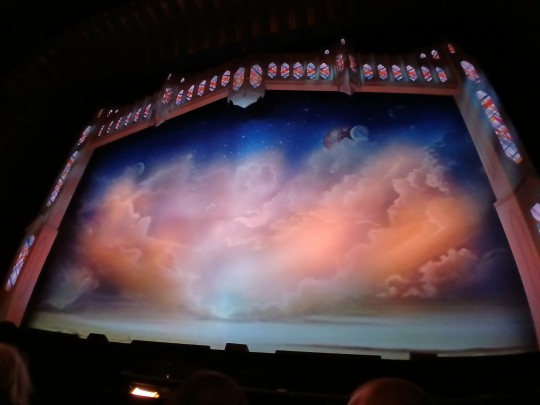
Also yes I had an insanely good seat, row B baby! I have never been this close to the stage ever and i was so giddy. It's genuinely so cool being able to see all the little details on the props up close!
The costume design was also incredible, I've found out it's standardised across all the performances so it's not exactly a perk of this specific performance but I still want to yap about it! The demon costume for the General was so freaking awesome, honestly all the costumes for SMHD were cool as hell. Genuinely I encourage you to look up a video of this song being performed because whilst it won't be as cool as seeing it live (and from what I've seen the sets aren't as cool as the one I saw), the costumes are awesome and the song is just genuinely fun to see performed!
The two main characters were obviously the highlight of the show, their chemistry was crazy and every single moment they had together just had me smiling so wide, they're absolutely perfect. Kevin my beloved I could never hate him 🙏🙏🙏‼️‼️ Even if the rest of the show wasn't as good as it is, I'd still love it purely because of these two. They're so silly 😭😭💖💖🌸🌸🌸
Also I just want to mention that during Turn It Off, Kevin has a vest like all the rest of the elders and he looks so fucking confused it was amazing, as soon as the dance bit is over bro just rips it off and goes to sit with an equally confused Arnold who comforts him it's so funny 😭😭😭 literally acted perfectly I adored it
10/10. The plot of this show isn't much to ride home about, it's not like a life changing experience or anything, but it doesn't have to be! Its a musical! The Book of Mormon is just a genuinely fun, creative, hilarious show and I enjoyed every minute of it! I was genuinely desperate to see it again and I have never felt that way about a show before now. It completely smashes what it sets out to accommplish and I wouldn't change a thing about it. Not my favourite musical ever but honestly I think it knocked Waitress out of my top 5 lmao, sorry Waitress- I would put it at Number 3 or 4 probably!
And now!!! Ranking time!!!
6. Six
5. Your Lie In April
4. Dear Evan Hansen
3. Waitress
2. Hamilton
1. Book Of Mormon
This was genuinely really fun to do and I love going to see musicals so this genuinely might become a yearly thing! I'm seeing a decent number this year despite thinking I wasn't going to as shows keep popping up so ill probably have enough for another list like this! (spoiler alert I'm almost 100% convinced that Hadestown will be my number 1 but we'll see!!! Literally my only exposure to that show has been ads as I want to go in as blind as possible past what I already know Greek myth wise but I know it'll be spectacular)
If you've gotten to the end thank you for reading, I really appreciate it‼️‼️‼️💖💖💖🌸🌸🌸 I know it's a long ass post
#musicals#musical review#six#hamilton#dear evan hansen#waitress#your lie in april#musical theatre#book of mormon#the book of mormon#ranking#rai rambles
7 notes
·
View notes